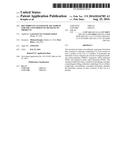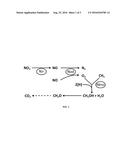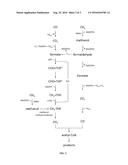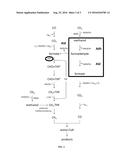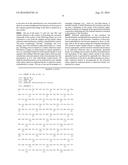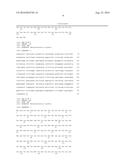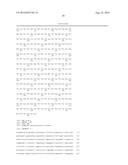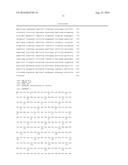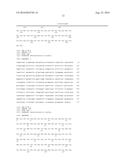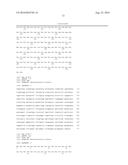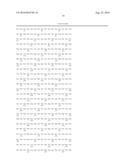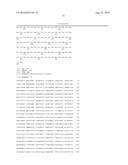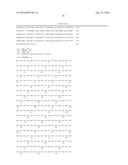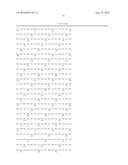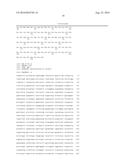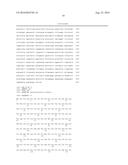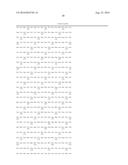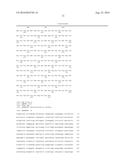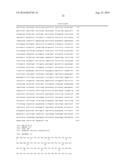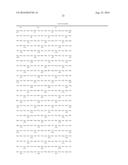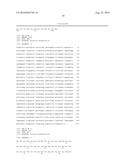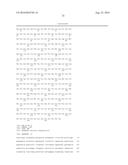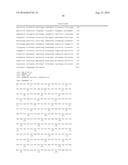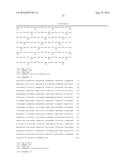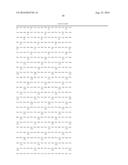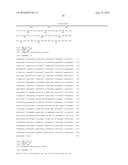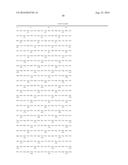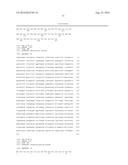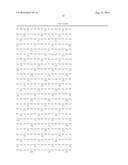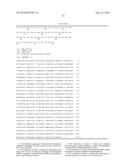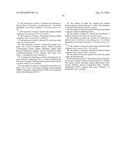Patent application title: RECOMBINANT ACETOGENIC BACTERIUM FOR THE CONVERSION OF METHANE TO PRODUCTS
Inventors:
IPC8 Class: AC12P104FI
USPC Class:
1 1
Class name:
Publication date: 2016-08-25
Patent application number: 20160244785
Abstract:
The invention provides a recombinant, acetogenic bacterium that consumes
a substrate comprising CH.sub.4 and converts at least a portion of the
CH.sub.4 to a product. In particular, the bacterium of may comprise one
or more of exogenous methane monooxygenase (MMO), exogenous nitrite
reductase (NIR), and exogenous nitric oxide dismutase (NOD). The
invention further provides a method for producing a product comprising
providing a substrate comprising CH.sub.4 to a culture comprising a
recombinant, acetogenic bacterium, whereby the bacterium converts at
least a portion of the CH.sub.4 to a product.Claims:
1. A recombinant, acetogenic bacterium that consumes a substrate
comprising CH.sub.4 and converts at least a portion of the CH.sub.4 to a
product.
2. The bacterium of claim 1, wherein the bacterium comprises one or more of exogenous methane monooxygenase (MMO), exogenous nitrite reductase (NIR), and exogenous nitric oxide dismutase (NOD).
3. The bacterium of claim 2, wherein the methane monooxygenase, nitrite reductase, or nitric oxide dismutase are derived from Methylomirabilis oxyfera.
4. The bacterium of claim 2, wherein the bacterium further comprises exogenous methanol methyltransferase.
5. The bacterium of claim 1, wherein the bacterium is a member of genus Clostridium or Acetobacterium.
6. The bacterium of claim 1, wherein the bacterium is derived from Clostridium autoethanogenum, Clostridium ljungdahlii, Clostridium ragsdalei, or Acetobacterium woodii.
7. The bacterium of claim 1, wherein the substrate further comprises one or more of CO, CO.sub.2, and H.sub.2.
8. The bacterium of claim 1, wherein the substrate further comprises one or more of NO.sub.2.sup.- and NO.sub.3.sup.-.
9. The bacterium of claim 1, wherein CH.sub.4 is the sole carbon source for the bacterium.
10. The bacterium of claim 1, wherein the product comprises one or more of ethanol, acetate, butanol, butyrate, 2,3-butanediol, lactate, butene, butadiene, methyl ethyl ketone (2-butanone), ethylene, acetone, isopropanol, lipids, 3-hydroxypropionate (3-HP), isoprene, fatty acids, 2-butanol, 1,2-propanediol, and 1-propanol.
11. A method for producing a product comprising providing a substrate comprising CH.sub.4 to a culture comprising the bacterium of claim 1, whereby the bacterium converts at least a portion of the CH.sub.4 to a product.
12. The method of claim 11, wherein the bacterium comprises one or more of exogenous methane monooxygenase (MMO), exogenous nitrite reductase (NIR), and exogenous nitric oxide dismutase (NOD).
13. The method of claim 12, wherein the methane monooxygenase, nitrite reductase, or nitric oxide dismutase are derived from Methylomirabilis oxyfera.
14. The method of claim 12, wherein the bacterium further comprises methanol methyltransferase.
15. The method of claim 11, wherein the bacterium is a member of genus Clostridium or Acetobacterium.
16. The method of claim 11, wherein the bacterium is derived from Clostridium autoethanogenum, Clostridium ljungdahlii, Clostridium ragsdalei, or Acetobacterium woodii.
17. The method of claim 11, wherein the substrate further comprises one or more of CO, CO.sub.2, and H.sub.2.
18. The method of claim 11, wherein the substrate further comprises one or more of NO.sub.2.sup.- and NO.sub.3.sup.-.
19. The method of claim 11, wherein CH.sub.4 is the sole carbon source for the bacterium.
20. The method of claim 11, wherein the product comprises one or more of ethanol, acetate, butanol, butyrate, 2,3-butanediol, lactate, butene, butadiene, methyl ethyl ketone (2-butanone), ethylene, acetone, isopropanol, lipids, 3-hydroxypropionate (3-HP), isoprene, fatty acids, 2-butanol, 1,2-propanediol, and 1-propanol.
Description:
CROSS REFERENCE TO RELATED APPLICATIONS
[0001] This application claims the benefit of U.S. Patent Application 62/119,632 filed Feb. 23, 2015, the entirety of which is incorporated herein by reference.
BACKGROUND OF THE INVENTION
[0002] Methane (CH.sub.4) is the second most prevalent greenhouse gas emitted in the United States, accounting for about 9% of all United States greenhouse gas emissions from human activities in 2012. Methane is emitted by natural sources such as wetlands, as well as human activities such as natural gas systems and agriculture. Additionally, methane is much more efficient at trapping radiation than carbon dioxide (CO.sub.2), the most prevalent greenhouse gas emitted in the United States. In fact, pound for pound, the comparative impact of methane on climate change is over 20 times greater than carbon dioxide over a 100-year period (United States Environmental Protection Agency).
[0003] Methanotrophs are microorganisms that oxidize methane to carbon dioxide and water via the intermediates methanol, formaldehyde, and formate. They play a major role in reducing the methane released from natural environments such as rice paddies, landfills, bogs, and swamps, where methane production is relatively high. As such, methanotrophs have attracted attention from environmental scientists for their potential in bioremediation efforts, namely the reduction of atmospheric methane levels and the mitigation of the effects of global warming.
[0004] Aerobic methanotrophs overcome the high activation energy (439 kJ/mol) (Trotsenko, Adv Appl Microbiol, 63: 183-229, 2008) required to break the C--H bond of methane by using oxygen as a highly reactive co-substrate for the initial attack, in a reaction catalysed by methane monooxygenase. In particular, methane monooxygenase uses two reducing equivalents from NAD(P)H to split the O--O bond of O.sub.2, whereby one atom is reduced to water and the second atom is incorporated into the substrate to yield methanol: CH.sub.4+NAD(P)H+H.sup.++O.sub.2.fwdarw.CH.sub.3OH+NAD(P).sup.++H.sub.2O. However, gaseous substrates comprising methane and oxygen are highly combustible, rendering industrial-scale growth of aerobic methanotrophs problematic, if not prohibitively dangerous.
[0005] Prior to the discovery of Candidatus Methylomirabilis oxyfera (Ettwig, Nature, 464: 543-548, 2010), it was believed that that anaerobic oxidation of methane by a single microorganism was biologically impossible (Wu, Biochem Soc Trans, 39: 243-248, 2011). Instead of scavenging oxygen from the environment, like the aerobic methanotrophs, or driving methane oxidation by reverse methanogenesis, like the methanogenic archaea in syntrophic consortia of methanotrophic archaea and reducing bacteria, M. oxyfera produces its own supply of oxygen by metabolizing nitrite via nitric oxide into oxygen and dinitrogen gas (Raghoebarsing, Nature, 440: 918-921, 2006; Ettwig, Appl Environ Microbiol, 75: 3656-3662, 2009; Hu, Environ Microbiol Rep, 1: 377-384, 2009; Ettwig, Nature, 464: 543-548, 2010; Luesken, Environ Microbiol, 14: 1024-1034, 2012). The intracellularly produced oxygen is then used for the oxidation of methane by the classical aerobic methane oxidation pathway involving methane monooxygenase (Ettwig, Nature, 464: 543-548, 2010).
[0006] Although M. oxyfera does not require a combustible gaseous substrate containing methane and oxygen like aerobic methanotrophs, M oxyfera has not yet been isolated in pure culture, grown at scale, or shown to produce any commercially valuable products. Accordingly, there remains a strong need for microorganisms and methods capable of converting methane to useful products, such as alcohols or acids.
SUMMARY OF THE INVENTION
[0007] The invention provides a recombinant, acetogenic bacterium that consumes a substrate comprising CH.sub.4 and converts at least a portion of the CH.sub.4 to a product. The invention further provides a method for producing a product comprising providing a substrate comprising CH.sub.4 to a culture comprising a recombinant, acetogenic bacterium, whereby the bacterium converts at least a portion of the CH.sub.4 to a product. In particular, the bacterium may comprise one or more of exogenous methane monooxygenase (MMO), exogenous nitrite reductase (NIR), and exogenous nitric oxide dismutase (NOD).
[0008] In one embodiment, the methane monooxygenase, nitrite reductase, or nitric oxide dismutase are derived from Methylomirabilis oxyfera. The methane monooxygenase may be Methylomirabilis oxyfera particulate methane monooxygenase A-subunit (EC: 1.14.13.25) (SEQ ID NO: 1), particulate methane monooxygenase B-subunit (EC: 1.14.13.25) (SEQ ID NO: 3), particulate methane monooxygenase C-subunit (EC: 1.14.13.25) (SEQ ID NO: 5), or particulate methane monooxygenase C-subunit2 (EC: 1.14.13.25) (SEQ ID NO: 7). The methane monooxygenase may be encoded by Methylomirabilis oxyfera particulate methane monooxygenase A-subunit (pmoA) (SEQ ID NO: 2), particulate methane monooxygenase B-subunit (pmoB) (SEQ ID NO: 4), particulate methane monooxygenase C-subunit (pmoC) (SEQ ID NO: 6), or particulate methane monooxygenase C-subunit2 (pmoC2) (SEQ ID NO: 8). The nitrite reductase may be Methylomirabilis oxyfera nitrite reductase, cytochrome cd1 type (EC: 1.7.2.1) (SEQ ID NO: 9). The nitrite reductase may be encoded by Methylomirabilis oxyfera nitrite reductase, cytochrome cd1 type (nirS) (SEQ ID NO: 10). The nitric oxide dismutase may be Methylomirabilis oxyfera cytochrome c oxidase subunit I (EC: 1.7.2.5) (SEQ ID NO: 11 or 13). The nitric oxide dismutase may be encoded by Methylomirabilis oxyfera cytochrome c oxidase subunit I (norZ) (SEQ ID NO: 12 or 14).
[0009] In one embodiment, the bacterium of the invention further comprises exogenous methanol methyltransferase. The methanol methyltransferase may be derived from Acetoanaerobium romashkovii, Acetobacterium carbolinicum, Acetobacterium dehalogenans, Acetobacterium psammolithicum, Acetobacterium tundrae, Acetobacterium woodii, Butyribacterium methylotrophicum, Clostridium clariflavum, Clostridium formicoaceticum, Clostridium magnum, Clostridium ethoxybenzovorans, Desulfosporosinus meridiei, Eubacterium aggregans, Eubacterium limosum, Moorella mulderi, Moorella thermoacetica, Moorella thermoautotrophica, Sporomusa acidovorans, Sporomusa aerivorans, Sporomusa malonica, Sporomusa paucivorans, Sporomusa silvacetica, Sporomusa termitida, or Thermoacetogenium phaeum. The methanol methyltransferase may be Moorella thermoacetica methanol: corrinoid methyltransferase (EC: 2.1.1.90) (SEQ ID NO: 15), Moorella thermoacetica methanol:corrinoid methyltransferase (EC: 2.1.1.246) (SEQ ID NO: 17 or 19), Acetobacterium woodii methanol:corrinoid methyltransferase (EC: 2.1.1.90) (SEQ ID NO: 21), Eubacterium limosum methanol:corrinoid methyltransferase (EC: 2.1.1.90) (SEQ ID NO: 23), or Thermoacetogenium phaeum methanol:corrinoid methyltransferase (EC: 2.1.1.90) (SEQ ID NO: 25). The methanol methyltransferase may be encoded by Moorella thermoacetica methanol:corrinoid methyltransferase (mtaB) (SEQ ID NO: 16), Moorella thermoacetica methanol:corrinoid methyltransferase (mtaA) (SEQ ID NO: 18 or 20), Acetobacterium woodii methanol:corrinoid methyltransferase (mttB18) (SEQ ID NO: 22), Eubacterium limosum methanol:corrinoid methyltransferase (mtaB) (SEQ ID NO: 24), or Thermoacetogenium phaeum methanol:corrinoid methyltransferase (mtaB) (SEQ ID NO: 26).
[0010] In one embodiment, the bacterium of the invention is a member of genus Clostridium or Acetobacterium. For example, the bacterium of the invention may be derived from Clostridium autoethanogenum, Clostridium ljungdahlii, Clostridium ragsdalei, or Acetobacterium woodii. In a preferred embodiment, the bacterium of the invention is derived from Clostridium autoethanogenum deposited under DSMZ accession number DSM23693.
[0011] In addition to CH.sub.4, the substrate may further comprise one or more of CO, CO.sub.2, and H.sub.2. In one embodiment, the substrate may further comprise one or more of NO.sub.2.sup.- and NO.sub.3.sup.-. In another embodiment, CH.sub.4 is the sole carbon source for the bacterium of the invention. The CH.sub.4 may be sourced, for example, from natural gas, agriculture, landfills, wastewater, or biogas production plants.
[0012] The bacterium of the invention typically produces one or more products, such as ethanol, acetate, butanol, butyrate, 2,3-butanediol, lactate, butene, butadiene, methyl ethyl ketone (2-butanone), ethylene, acetone, isopropanol, lipids, 3-hydroxypropionate (3-HP), isoprene, fatty acids, 2-butanol, 1,2-propanediol, and 1-propanol.
BRIEF DESCRIPTION OF THE DRAWINGS
[0013] FIG. 1 is a diagram showing the reactions catalyzed by MMO, NIR, and NOD.
[0014] FIG. 2 is a diagram showing the incorporation of a methane utilization module into the Wood-Ljungdahl pathway of acetogens.
[0015] 0015 FIG. 3 is a diagram showing methane to formate conversion using an alcohol dehydrogenase (Adh) and an aldehyde dehydrogenase (Ald).
DETAILED DESCRIPTION OF THE INVENTION
[0016] An "acetogen" is a microorganism that generates or is capable of generating acetate as a product of anaerobic respiration. Typically, acetogens are obligate anaerobic bacteria that use the Wood-Ljungdahl pathway as their main mechanism for energy conservation and for synthesis of acetyl-CoA and acetyl-CoA-derived products, such as acetate (Ragsdale, Biochim Biophys Acta, 1784: 1873-1898, 2008). Acetogens can use a wide variety of carbon sources, including carbon dioxide, carbon monoxide, formate, methanol, methyl groups from methoxylated aromatic compounds, sugars, glyoxylate, glycolate, oxalate, lactate, pyruvate, and short-chain fatty acids (Ragsdale, Biochim Biophys Acta, 1784: 1873-1898, 2008). However, acetogens have never been shown to use CH.sub.4 as a carbon source.
[0017] The invention provides a recombinant, acetogenic bacterium that consumes a substrate comprising CH.sub.4 and converts at least a portion of the CH.sub.4 to a product. Additionally, the invention provides a method for producing a product comprising providing a substrate comprising CH.sub.4 to a culture comprising a recombinant, acetogenic bacterium, whereby the bacterium converts the CH.sub.4 to a product.
[0018] In particular, the bacterium of the invention may comprise one or more of methane monooxygenase (MMO), nitrite reductase (NIR), and nitric oxide dismutase (NOD). Specifically, the bacterium of the invention may comprise one or more of exogenous MMO, exogenous NIR, and exogenous NOD. In one embodiment, the bacterium of the invention comprises exogenous MMO, but not exogenous NIR or exogenous NOD. In another embodiment, the bacterium of the invention comprises each of exogenous MMO, exogenous NIR, and exogenous NOD. The MMO, NIR, and NOD, or the genes encoding the MMO, NIR, and NOD, may be derived from any suitable microorganism. Preferably, the MMO, NIR, and NOD, or the genes encoding the MMO, NIR, and NOD, are derived from M. oxyfera.
[0019] Methane monooxygenase (MMO) belongs to the class of oxidoreductase enzymes and oxidizes the C--H bond in methane and other alkanes (EC: 1.14.13.25). In particular, MMO uses two reducing equivalents from NAD(P)H to split the O--O bond of O.sub.2, whereby one atom is reduced to water by a 2 e.sup.- reduction and the second atom is incorporated into the substrate to yield methanol: CH.sub.4+O.sub.2+NAD(P)H+H.sup.+.fwdarw.CH.sub.3OH+NAD(P).sup.++H.sub.2O. Furthermore, MMO has been described to oxidize CO to CO.sub.2 (Bedard, Microbiol Rev, 53: 68-84, 1989). While methanotrophs are unable to utilize CO.sub.2, many acetogens, including carboxydotrophic acetogens such as C. autoethanogenum, are able to utilize CO.sub.2. Accordingly, expression of MMO in an acetogen would allow for not only methane utilization, but also increased CO oxidation and increased CO.sub.2 utilization. The MMO may be or may be derived from M. oxyfera particulate methane monooxygenase A-subunit (EC: 1.14.13.25) (KEGG DAMO 2450) (SEQ ID NO: 1), particulate methane monooxygenase B-subunit (EC: 1.14.13.25) (KEGG DAMO_2448) (SEQ ID NO: 3), particulate methane monooxygenase C-subunit (EC: 1.14.13.25) (KEGG DAMO_2451) (SEQ ID NO: 5), or particulate methane monooxygenase C-subunit2 (EC: 1.14.13.25) (KEGG DAMO_2339) (SEQ ID NO: 7). Additionally, the MMO may be encoded by a gene comprising or derived from M. oxyfera particulate methane monooxygenase A-subunit (pmoA) (KEGG DAMO_2450) (SEQ ID NO: 2), particulate methane monooxygenase B-subunit (pmoB) (KEGG DAMO_2448) (SEQ ID NO: 4), particulate methane monooxygenase C-subunit (pmoC) (KEGG DAMO_2451) (SEQ ID NO: 6), or particulate methane monooxygenase C-subunit2 (pmoC2) (KEGG DAMO_2339) (SEQ ID NO: 8).
[0020] Nitrite reductase (NIR) catalyses the reduction of nitrite (NO.sub.2.sup.-) to nitric oxide (NO) (EC: 1.7.2.1). The NIR may be or may be derived from M. oxyfera nitrite reductase, cytochrome cd1 type (nirS) (EC: 1.7.2.1) (KEGG DAMO_2415) (SEQ ID NO: 9). Additionally, the NIR may be encoded by a gene comprising or derived from M. oxyfera nitrite reductase, cytochrome cd1 type (nirS) (KEGG DAMO_2415) (SEQ ID NO: 10). In certain embodiments, NIR is present natively (endogenously), such as in Clostridium autoethanogenum (YP_008699106). However, even in embodiments where NIR is present natively, it may be necessary to introduce an additional exogenous NIR that is better able to form a complex with and/or interact with MMO.
[0021] Nitric oxide dismutase (NOD) catalyses the reaction of two molecules of NO into N.sub.2 and O.sub.2. The O.sub.2 can then be immediately used in the MMO reaction. The NOD may be or may be derived from M. oxyfera cytochrome c oxidase subunit I (EC: 1.7.2.5) (KEGG DAMO_2434 or DAMO_2437) (SEQ ID NO: 11 or 13). Additionally, the NOD may be encoded by a gene comprising or derived from M. oxyfera cytochrome c oxidase subunit I (norZ) (KEGG DAMO_2434 or DAMO_2437) (SEQ ID NO: 12 or 14). In certain embodiments, NOD is present natively (endogenously), such as in Clostridium autoethanogenum (YP008698458). However, even in embodiments where NOD is present natively, it may be necessary to introduce an additional exogenous NOD that is better able to form a complex with and/or interact with MMO.
[0022] In certain embodiments, the bacterium of the invention further comprises exogenous methanol methyltransferase. Methanol methyltransferase is responsible for conversion of methanol into the methyl-group of methylenetetrahydrofolate which can then be transferred to the methyl group of acetyl-CoA catalyzed by methyltransferase, corrinoid protein, and CO dehydrogenase/acetyl CoA synthase enzymes of the Wood-Ljungdahl pathway of acetogenic microorganisms. In some microorganisms, a methanol methyltransferase is present natively (endogenously), such as in Aetoanaerobium romashkovii, Acetobacterium carbolinicum, Acetobacterium dehalogenans, Acetobacterium psammolithicum, Acetobacterium tundrae, Acetobacterium woodii, Butyribacterium methylotrophicum, Clostridium clariflavum, Clostridium formicoaceticum, Clostridium magnum, Clostridium ethoxybenzovorans, Desulfosporosinus meridiei, Eubacterium aggregans, Eubacterium limosum, Moorella mulderi, Moorella thermoacetica, Moorella thermoautotrophica, Sporomusa acidovorans, Sporomusa aerivorans, Sporomusa malonica, Sporomusa paucivorans, Sporomusa silvacetica, Sporomusa termitida, and Thermoacetogenium phaeum. In these embodiments, it is not required for the bacterium of the invention to comprise exogenous methanol methyltransferase. However, other microorganisms, such as Clostridium autoethanogenum, do not have a native methanol methyltransferase. In these microorganisms, it may be necessary to provide the bacterium of the invention with an exogenous methanol methyltransferase. While the Wood-Ljungdahl pathway is ATP negative (i.e., requires ATP for formate activation), methanol methyltransferase allows the energy-requiring step of the Wood-Ljungdahl pathway to be circumvented, providing the microorganism with additional energy for product synthesis.
[0023] The methanol methyltransferase may be derived from any suitable microorganism. In particular, the methanol methyltransferase may be derived from Acetoanaerobium romashkovii, Acetobacterium carbolinicum, Acetobacterium dehalogenans, Acetobacterium psammolithicum, Acetobacterium tundrae, Acetobacterium woodii, Butyribacterium methylotrophicum, Clostridium clariflavum, Clostridium formicoaceticum, Clostridium magnum, Clostridium ethoxybenzovorans, Desulfosporosinus meridiei, Eubacterium aggregans, Eubacterium limosum, Moorella mulderi, Moorella thermoacetica, Moorella thermoautotrophica, Sporomusa acidovorans, Sporomusa aerivorans, Sporomusa malonica, Sporomusa paucivorans, Sporomusa silvacetica, Sporomusa termitida, or Thermoacetogenium phaeum.
[0024] In one embodiment, the methanol methyltransferase, or the gene encoding the methanol methyltransferase, is derived from Moorella thermoacetica. The methanol methyltransferase may be or may be derived from Moorella thermoacetica methanol:corrinoid methyltransferase (EC: 2.1.1.90) (KEGG Moth_1209) (SEQ ID NO: 15) or methanol:corrinoid methyltransferase (EC: 2.1.1.246) (KEGG Moth_2346 or Moth_2100) (SEQ ID NO: 17 or 19). Additionally, the methanol methyltransferase may be encoded by a gene comprising or derived from Moorella thermoacetica methanol:corrinoid methyltransferase (mtaB) (KEGG Moth_1209) (SEQ ID NO: 16) or methanol:corrinoid methyltransferase (mtaA) (KEGG Moth_2346 or Moth_2100) (SEQ ID NO: 18 or 20).
[0025] In one embodiment, the methanol methyltransferase, or the gene encoding the methanol methyltransferase, is derived from Acetobacterium woodii (Kerby, J Bacteriol, 155: 1208-1218, 1983), Eubacterium limosum (Genthner, Appl Environ Microbiol, 42: 12-19, 1981), or Thermoacetogenium phaeum. The methanol methyltransferase may be or may be derived from Acetobacterium woodii methanol:corrinoid methyltransferase (EC: 2.1.1.90) (KEGG Awo_c22760) (SEQ ID NO: 21), Eubacterium limosum methanol:corrinoid methyltransferase (EC: 2.1.1.90) (KEGG ELI_2003) (SEQ ID NO: 23), or Thermoacetogenium phaeum methanol:corrinoid methyltransferase (EC: 2.1.1.90) (KEGG Tph_c03590) (SEQ ID NO: 26). Additionally, the methanol methyltransferase may be encoded by a gene comprising or derived from Acetobacterium woodii methanol:corrinoid methyltransferase (mttB18) (KEGG Awo_c22760) (SEQ ID NO: 22), Eubacterium limosum methanol:corrinoid methyltransferase (mtaB) (KEGG ELI_2003) (SEQ ID NO: 24), or Thermoacetogenium phaeum methanol:corrinoid methyltransferase (mtaB) (KEGG Tph_c03590) (SEQ ID NO: 26).
[0026] In certain embodiments, the bacterium of the invention further comprises one or both of exogenous alcohol dehydrogenase (Adh) and exogenous aldehyde dehydrogenase (Ald), which enzymes may be required for conversion of methanol to formate (FIG. 3) (Witthoff, Appl Environ Microbiol, 79: 6974-6983, 2013). In some embodiments, the bacterium of the invention may natively comprise Adh or Ald, such that exogenous Adh or Ald may not be required. For example, Clostridium ljungdahlii natively comprises two Adh enzymes capable of converting methanol to formate (Tan, J Basic Microbiol, 54: 996-1004, 2014). Homologues of these enzymes are present in Clostridium autoethanogenum (KEGG CAETHG_0555 and CAETHG_1841). However, even in bacteria that natively comprise one or both of Adh and Ald, incorporation of exogenous Adh or Ald into the bacterium of the invention may enhance the conversion of formate to methanol.
[0027] "Endogenous" refers to a nucleic acid or protein that is present or expressed in the wild-type or parental bacterium from which the recombinant bacterium of the invention is derived. For example, an endogenous gene is a gene that is natively present in the wild-type or parental bacterium from which the recombinant bacterium of the invention is derived. In one embodiment, the expression of an endogenous gene may be controlled by an exogenous regulatory element, such as an exogenous promoter.
[0028] "Exogenous" refers to a nucleic acid or protein that is not present in the wild-type or parental microorganism from which the bacterium of the invention is derived. In one embodiment, an exogenous gene or enzyme may be derived from a heterologous strain or species and introduced to or expressed in the bacterium of the invention. In another embodiment, an exogenous gene or enzyme may be artificially or recombinantly created and introduced to or expressed in the bacterium of the invention. Exogenous nucleic acids may be adapted to integrate into the genome of the bacterium of the invention or to remain in an extra-chromosomal state in the bacterium of the invention, for example, in a plasmid.
[0029] "Enzyme activity" refers broadly to enzymatic activity, including, but not limited, to the activity of an enzyme, the amount of an enzyme, or the availability of an enzyme to catalyze a reaction. Accordingly, "increasing" enzyme activity includes increasing the activity of an enzyme, increasing the amount of an enzyme, or increasing the availability of an enzyme to catalyze a reaction.
[0030] "Mutated" refers to a nucleic acid or protein that has been modified in the bacterium of the invention compared to the wild-type or parental microorganism from which the bacterium of the invention is derived. In one embodiment, the mutation may be a deletion, insertion, or substitution in a gene encoding an enzyme. In another embodiment, the mutation may be a deletion, insertion, or substitution of one or more amino acids in an enzyme.
[0031] "Codon optimization" refers to the mutation of a nucleic acid, such as a gene, for optimized or improved translation of the nucleic acid in a particular strain or species. Codon optimization may result in faster translation rates or higher translation accuracy. In a preferred embodiment, the genes of the invention are codon optimized for expression in Clostridium, particularly Clostridium autoethanogenum, Clostridium ljungdahlii, or Clostridium ragsdalei. In a further preferred embodiment, the genes of the invention are codon optimized for expression in Clostridium autoethanogenum LZ1561, which is deposited under DSMZ accession number DSM23693.
[0032] "Overexpressed" refers to an increase in expression of a nucleic acid or protein in the bacterium of the invention compared to the wild-type or parental bacterium from which the bacterium of the invention is derived. Overexpression may be achieved by any means known in the art, including modifying gene copy number, gene transcription rate, gene translation rate, or enzyme degradation rate.
[0033] The term "genetic modification" broadly refers to manipulation of the genome or nucleic acids of a microorganism. Methods of genetic modification include heterologous gene expression, gene or promoter insertion or deletion, altered gene expression or inactivation, enzyme engineering, directed evolution, knowledge-based design, random mutagenesis methods, gene shuffling, and codon optimization. Such methods are described, for example, in Sambrook, Molecular Cloning: A Laboratory Manual, Cold Spring Harbor Laboratory Press, Cold Spring Harbor, N.Y., 2001; Pleiss, Curr Opin Biotechnol, 22: 611-617, 2011; Park, Protein Engineering and Design, CRC Press, 2010.
[0034] The term "variants" includes nucleic acids and proteins whose sequence varies from the sequence of a reference nucleic acid and protein, such as a sequence of a reference nucleic acid and protein disclosed in the prior art or exemplified herein. The invention may be practiced using variant nucleic acids or proteins that perform substantially the same function as the reference nucleic acid or protein. For example, a variant protein may perform substantially the same function or catalyze substantially the same reaction as a reference protein. A variant gene may encode the same or substantially the same protein as a reference gene. A variant promoter may have substantially the same ability to promote the expression of one or more genes as a reference promoter.
[0035] Such nucleic acids or proteins may be referred to herein as "functionally equivalent variants." By way of example, functionally equivalent variants of a nucleic acid may include allelic variants, fragments of a gene, mutated genes, polymorphisms, and the like. Homologous genes from other microorganisms are also examples of functionally equivalent variants. These include homologous genes in species such as Clostridium acetobutylicum, Clostridium beijerinckii, or Clostridium ljungdahlii, the details of which are publicly available on websites such as Genbank or NCBI. Functionally equivalent variants also includes nucleic acids whose sequence varies as a result of codon optimization for a particular organism. A functionally equivalent variant of a nucleic acid will preferably have at least approximately 70%, approximately 80%, approximately 85%, approximately 90%, approximately 95%, approximately 98%, or greater nucleic acid sequence identity (percent homology) with the referenced nucleic acid. A functionally equivalent variant of a protein will preferably have at least approximately 70%, approximately 80%, approximately 85%, approximately 90%, approximately 95%, approximately 98%, or greater amino acid identity (percent homology) with the referenced protein. The functional equivalence of a variant nucleic acid or protein may be evaluated using any method known in the art.
[0036] Nucleic acids may be delivered to a bacterium of the invention using any method known in the art. For example, nucleic acids may be delivered as naked nucleic acids or may be formulated with one or more agents (e.g., liposomes). The nucleic acids may be DNA, RNA, cDNA, or combinations thereof, as is appropriate. Restriction inhibitors may be used in certain embodiments (Murray, Microbiol Molec Biol Rev, 64: 412-434, 2000). Additional vectors may include plasmids, viruses (including bacteriophage), cosmids, and artificial chromosomes. In a preferred embodiment, nucleic acids are delivered to the bacterium of the invention using a plasmid.
[0037] By way of example, transformation (including transduction or transfection) may be achieved by electroporation, ultrasonication, polyethylene glycol-mediated transformation, chemical or natural competence, protoplast transformation, prophage induction, or conjugation (see, e.g., Molecular Cloning: A Laboratory Manual, Cold Spring Harbor Laboratory Press, Cold Spring Harbor, N.Y., 1989). The use of electroporation has been reported for several carboxydotrophic acetogens, including Clostridium ljungdahlii (Kopke, PNAS, 107:13087-13092, 2010; WO/2012/053905), Clostridium autoethanogenum (WO/2012/053905), Clostridium aceticum (Schiel-Bengelsdorf, Synthetic Biol, 15: 2191-2198, 2012), and Acetobacterium woodii (Stratz, Appl Environ Microbiol, 60: 1033-1037, 1994). The use of electroporation has also been reported in Clostridia, including Clostridium acetobutylicum (Mermelstein, Biotechnol, 10: 190-195, 1992), and Clostridium cellulolyticum (Jennert, Microbiol, 146: 3071-3080, 2000). Prophage induction has been demonstrated for carboxydotrophic acetogens, including Clostridium scatologenes (Parthasarathy, Development of a Genetic Modification System in Clostridium scatologenes ATCC 25775 for Generation of Mutants, Masters Project, Western Kentucky University, 2010), and conjugation been described for many Clostridia, including Clostridium difficile (Herbert, FEMS Microbiol Lett, 229: 103-110, 2003) and Clostridium acetobuylicum (Williams, J Gen Microbiol, 136: 819-826, 1990). In certain embodiments having active restriction enzyme systems, it may be necessary to methylate a nucleic acid before introduction of the nucleic acid into the bacterium of the invention.
[0038] A "microorganism" is a microscopic organism, especially a bacterium, archea, virus, or fungus. The microorganism of the invention is typically a bacterium. As used herein, recitation of "microorganism" should be taken to encompass "bacterium."
[0039] The term "recombinant" indicates that a nucleic acid, protein, or microorganism is the product of genetic modification or recombination. Generally, the term "recombinant" refers to a nucleic acid, protein, or microorganism that contains or is encoded by genetic material derived from multiple sources, such as two or more different strains or species of microorganisms. As used herein, the term "recombinant" may also be used to describe a microorganism that comprises a mutated nucleic acid or protein, including a mutated form of an endogenous nucleic acid or protein.
[0040] A "parental microorganism" is a microorganism used to generate a bacterium of the invention. The parental microorganism may be a naturally-occurring microorganism (i.e., a wild-type microorganism) or a microorganism that has been previously modified (i.e., a mutant or recombinant microorganism). The bacterium of the invention may be modified to express or overexpress one or more enzymes that were not expressed or overexpressed in the parental microorganism. Similarly, the bacterium of the invention may be modified to contain one or more genes that were not contained by the parental microorganism. In one embodiment, the parental organism is Clostridium autoethanogenum, Clostridium ljungdahlii, or Clostridium ragsdalei. In a preferred embodiment, the parental microorganism is Clostridium autoethanogenum LZ1561, which was deposited on Jun. 7, 2010 with Deutsche Sammlung von Mikroorganismen and Zellkulturen GmbH (DSMZ) located at Inhoffenstra.beta. 7B, D-38124 Braunschwieg, Germany on Jun. 7, 2010 under the terms of the Budapest Treaty and accorded accession number DSM23693.
[0041] The term "derived from" indicates that a nucleic acid, protein, or microorganism is modified or adapted from a different (e.g., a parental or wild-type) nucleic acid, protein, or microorganism, so as to produce a new nucleic acid, protein, or microorganism. Such modifications or adaptations typically include insertion, deletion, mutation, or substitution of nucleic acids or genes. Generally, the bacterium of the invention is derived from a parental microorganism. In one embodiment, the bacterium of the invention is derived from Clostridium autoethanogenum, Clostridium ljungdahlii, or Clostridium ragsdalei. In a preferred embodiment, the bacterium of the invention is derived from Clostridium autoethanogenum LZ1561, which is deposited under DSMZ accession DSM23693.
[0042] An "acetogen" is a microorganism that generates or is capable of generating acetate as a product of anaerobic respiration. Typically, acetogens are obligately anaerobic bacteria that use the Wood-Ljungdahl pathway as their main mechanism for energy conservation and for synthesis of acetyl-CoA and acetyl-CoA-derived products, such as acetate (Ragsdale, Biochim Biophys Acta, 1784: 1873-1898, 2008). Typically, the bacterium of the invention is an acetogen. The bacterium of the invention may be selected or derived from the genus Clostridium, Morella, Carboxydothermus, Acetogenium, Acetobacterium, Acetoanaerobium, Butyribaceterium, or Peptostreptococcus. In a preferred embodiment, the bacterium of the invention is a member of genus Clostridium. In a more preferred embodiment, the bacterium of the invention is derived from Clostridium autoethanogenum, Clostridium ljungdahlii, Clostridium ragsdalei, or Acetobacterium woodii. In an even more preferred embodiment, the bacterium of the invention is derived from Clostridium autoethanogenum deposited under DSMZ accession number DSM23693.
[0043] A "carboxydotroph" is a microorganism capable of tolerating a high concentration of carbon monoxide (CO). In one embodiment, the bacterium of the invention is a carboxydotroph.
[0044] The bacterium of the invention may be derived from the cluster of carboxydotrophic Clostridia comprising the species Clostridium autoethanogenum, Clostridium ljungdahlii, Clostridium ragsdalei, and related isolates, including, but not limited to, strains Clostridium autoethanogenum JAI-1T (DSM10061) (Abrini, Arch Microbiol, 161: 345-351, 1994), Clostridium autoethanogenum LBS1560 (DSM19630) (WO 2009/064200), Clostridium autoethanogenum LZ1561 (DSM23693), Clostridium ljungdahlii PETCT (DSM13528=ATCC 55383) (Tanner, Int J Syst Bacteriol, 43: 232-236, 1993), Clostridium ljungdahlii ERI-2 (ATCC 55380) (U.S. Pat. No. 5,593,886), Clostridium ljungdahlii C-01 (ATCC 55988) (U.S. Pat. No. 6,368,819), Clostridium ljungdahlii O-52 (ATCC 55989) (U.S. Pat. No. 6,368,819), Clostridium ragsdalei P11T (ATCC BAA-622) (WO 2008/028055), related isolates such as "Clostridium coskatii" (U.S. Publication 2011/0229947), or mutated strains such as Clostridium ljungdahlii OTA-1 (Tirado-Acevedo, Production of Bioethanol from Synthesis Gas Using Clostridium ljungdahlii, PhD thesis, North Carolina State University, 2010).
[0045] These strains form a subcluster within the Clostridial rRNA cluster I and their 16S rRNA gene is more than 99% identical with a similar low GC content of around 30%. However, DNA-DNA reassociation and DNA fingerprinting experiments showed that these strains belong to distinct species (WO 2008/028055). The strains of this cluster are defined by common characteristics, having both a similar genotype and phenotype, and they all share the same mode of energy conservation and fermentative metabolism. Furthermore, the strains of this cluster lack cytochromes and conserve energy via an Rnf complex. All species of this cluster have a similar morphology and size (logarithmic growing cells are between 0.5-0.7.times.3-5 .mu.m), are mesophilic (optimal growth temperature between 30-37.degree. C.), and are strictly anaerobic (Abrini, Arch Microbiol, 161: 345-351, 1994; Tanner, Int J Syst Bacteriol, 43: 232-236, 1993; and WO 2008/028055). Moreover, they all share the same major phylogenetic traits, such as same pH range (pH 4-7.5, with an optimal initial pH of 5.5-6), strong autotrophic growth on CO-containing gases with similar growth rates, and a similar metabolic profile with ethanol and acetic acid as main fermentation end products, and small amounts of 2,3-butanediol and lactic acid formed under certain conditions (Abrini, Arch Microbiol, 161: 345-351, 1994; Kopke, Curr Opin Biotechnol, 22: 320-325, 2011; Tanner, Int J Syst Bacteriol, 43: 232-236, 1993; and WO 2008/028055). Indole production was observed with all three species as well.
[0046] However, the species differentiate in substrate utilization of various sugars (e.g., rhamnose, arabinose), acids (e.g., gluconate, citrate), amino acids (e.g., arginine, histidine), or other substrates (e.g., betaine, butanol). Moreover some of the species were found to be auxotrophic to certain vitamins (e.g., thiamine, biotin) while others were not. The organization and number of Wood-Ljungdahl pathway genes, responsible for gas uptake, has been found to be the same in all species, despite differences in nucleic and amino acid sequences (Kopke, Curr Opin Biotechnol, 22: 320-325, 2011). Also, reduction of carboxylic acids into their corresponding alcohols has been shown in a range of these microorganisms (Perez, Biotechnol Bioeng, 110:1066-1077, 2012). These traits are therefore not specific to one microorganism, like Clostridium autoethanogenum or Clostridium ljungdahlii, but rather general traits for carboxydotrophic, ethanol-synthesizing Clostridia and it can be anticipated that mechanisms work similarly across these strains, although there may be differences in performance.
[0047] The term "substrate" refers to a carbon and/or energy source for the bacterium of the invention. Typically, the substrate is a gaseous substrate that comprises methane (CH.sub.4). The bacterium of the invention generally converts at least a portion of the CH.sub.4 in the substrate to a product. In one embodiment, CH.sub.4 is the sole carbon source for the bacterium of the invention. The CH.sub.4 may be sourced, for example, from natural gas, agriculture, landfills, wastewater, or biogas production plants.
[0048] Oftentimes, however, the substrate will also comprise carbon monoxide (CO). The substrate may comprise a major proportion of CO, such as about 20% to 99%, 20% to 70%, 30% to 60%, or 40% to 55% CO by volume. In particular embodiments, the substrate comprises about 25%, 30%, 35%, 40%, 45%, 50%, 55%, or 60% CO by volume.
[0049] While it is not necessary for the substrate to contain any hydrogen (H.sub.2), the presence of H.sub.2 should not be detrimental to product formation and may result in improved overall efficiency. For example, in particular embodiments, the substrate may comprise an approximate ratio of H.sub.2:CO of 2:1, 1:1, or 1:2. In one embodiment, the substrate comprises less than about 30%, 20%, 15%, or 10% H.sub.2 by volume. In other embodiments, the substrate comprises low concentrations of H.sub.2, for example, less than 5%, less than 4%, less than 3%, less than 2%, or less than 1% H.sub.2. In further embodiments, the substrate contains substantially no H.sub.2. The substrate may also contain carbon dioxide (CO.sub.2), for example, about 1% to 80% or 1% to 30% CO.sub.2 by volume. In one embodiment, the substrate comprises less than about 20% CO.sub.2 by volume. In further embodiments, the substrate comprises less than about 15%, 10%, or 5% CO.sub.2 by volume. In another embodiment, the substrate contains substantially no CO.sub.2.
[0050] In one embodiment, the substrate comprises CH.sub.4 and one or more of CO, CO.sub.2, and H.sub.2. Existing methods are currently unable to utilize CH.sub.4 and CO in parallel, although both gases are present in many gas streams. However, the invention provides a method of using a substrate comprising both CH.sub.4 and CO and a microorganism capable of consuming such a substrate, e.g., an acetogenic bacterium that consumes a substrate comprising at least CH.sub.4 and CO and converts at least a portion of the CH.sub.4 and CO to a product. The substrate comprise a PSA tail gas, a gas stream generated from processes involving hydrogen production and purification. The PSA tail gas may comprise both CH.sub.4 and CO. For example, the PSA tail gas may comprise approximately 12% CO, 25% H.sub.2, 46% CO.sub.2, and 17% CH.sub.4. The substrate may comprise a steam methane reforming tail gas comprising both CH.sub.4 and CO. For example, the steam methane reforming tail gas may comprise approximately 66% H.sub.2, 9% CO.sub.2, 22% CO, and 4% CH.sub.4.
[0051] The substrate may be a waste gas obtained as a by-product of an industrial process or from some other source, such as from automobile exhaust fumes or biomass gasification. In certain embodiments, the industrial process is selected from the group consisting of ferrous metal products manufacturing, such as a steel mill manufacturing, non-ferrous products manufacturing, petroleum refining processes, coal gasification, electric power production, carbon black production, ammonia production, methanol production, and coke manufacturing. In these embodiments, the CO-containing gas may be captured from the industrial process before it is emitted into the atmosphere, using any convenient method. The CO may be a component of syngas, i.e., a gas comprising carbon monoxide and hydrogen. The CO produced from industrial processes is normally flared off to produce CO.sub.2 and therefore the invention has particular utility in reducing CO.sub.2 greenhouse gas emissions. The composition of the substrate may have a significant impact on the efficiency and/or cost of the reaction. For example, the presence of oxygen (O.sub.2) may reduce the efficiency of an anaerobic fermentation process. Depending on the composition of the substrate, it may be desirable to treat, scrub, or filter the substrate to remove any undesired impurities, such as toxins, undesired components, or dust particles, and/or increase the concentration of desirable components.
[0052] The substrate may also be a blend of individual substrates. For example, the substrate may be obtained by blending a gaseous substrate comprising CH.sub.4 with a gaseous substrate comprising one or more of CO, CO.sub.2, and H.sub.2.
[0053] Additionally, the substrate may comprise one or more of nitric oxide (NO), nitrite (NO.sub.2.sup.-) and nitrate (NO.sub.3.sup.-). NO is required as substrate for NOD that catalyzes the reaction of two molecules of NO into N.sub.2 and O.sub.2. The O.sub.2 can then be immediately used for methane oxidation by the MMO. Nitric oxide itself can be derived from NO.sub.2.sup.- by NIR, which catalyzes the reduction of NO.sub.2.sup.- to NO. NO.sub.2.sup.- can be derived from NO.sub.3.sup.- by nitrate reductase which catalyses the reduction of NO.sub.3.sup.- to NO.sub.2.sup.-.
[0054] Although the substrate is typically gaseous, the substrate may also be provided in alternative forms. For example, the substrate may be dissolved in a liquid saturated with a CO-containing gas using a microbubble dispersion generator (Hensirisak, Appl Biochem Biotechnol, 101: 211-227, 2002). By way of further example, the substrate may be adsorbed onto a solid support. Moreover, certain components of the substrate (e.g., CH.sub.4, CO, CO.sub.2, and/or H.sub.2) may be provided in gaseous form while other components of the substrate (e.g., NO.sub.2.sup.- and/or nitrate NO.sub.3.sup.-) may be provided in liquid form.
[0055] The bacterium of the invention may be cultured to produce one or more products. Typically, the culture is performed in a bioreactor. The term "bioreactor" includes a culture/fermentation device consisting of one or more vessels, towers, or piping arrangements, such as a continuous stirred tank reactor (CSTR), immobilized cell reactor (ICR), trickle bed reactor (TBR), bubble column, gas lift fermenter, static mixer, or other vessel or other device suitable for gas-liquid contact. In some embodiments, the bioreactor may comprise a first growth reactor and a second culture/fermentation reactor. The substrate may be provided to one or both of these reactors. As used herein, the terms "culture" and "fermentation" are used interchangeably. These terms encompass both the growth phase and product biosynthesis phase of the culture/fermentation process.
[0056] The culture is generally maintained in an aqueous culture medium that contains nutrients, vitamins, and/or minerals sufficient to permit growth of the bacterium. Preferably the aqueous culture medium is a minimal anaerobic microbial growth medium. Suitable media are known in the art and described, for example, in U.S. Pat. No. 5,173,429, U.S. Pat. No. 5,593,886, and WO 2002/008438.
[0057] The culture/fermentation should desirably be carried out under appropriate conditions for production of the target product. Reaction conditions to consider include pressure (or partial pressure of CO), temperature, gas flow rate, liquid flow rate, media pH, media redox potential, agitation rate (if using a continuous stirred tank reactor), inoculum level, maximum gas substrate concentrations to ensure that CO in the liquid phase does not become limiting, and maximum product concentrations to avoid product inhibition. In particular, the rate of introduction of the CO-containing substrate may be controlled to ensure that the concentration of CO in the liquid phase does not become limiting, since products may be consumed by the culture under CO-limited conditions.
[0058] Operating a bioreactor at elevated pressures allows for an increased rate of gas mass transfer from the gas phase to the liquid phase. Accordingly, it is generally preferable to perform the culture/fermentation at pressures higher than atmospheric pressure. Also, since a given gas conversion rate is, in part, a function of the substrate retention time and retention time dictates the required volume of a bioreactor, the use of pressurized systems can greatly reduce the volume of the bioreactor required and, consequently, the capital cost of the culture/fermentation equipment. According to examples in U.S. Pat. No. 5,593,886, reactor volume can be reduced in linear proportion to increases in reactor operating pressure. In other words, a bioreactor operated at 10 atmospheres of pressure need only be one tenth the volume of a bioreactor operated at 1 atmosphere of pressure. Additionally, WO 2002/008438 describes gas-to-ethanol fermentations performed under pressures of 30 psig and 75 psig, giving ethanol productivities of 150 g/L/day and 369 g/L/day, respectively. In contrast, fermentations performed using similar media and input gas compositions at atmospheric pressure were found to produce between 10 and 20 times less ethanol per litre per day.
[0059] The bacterium of the invention may produce or be engineered to produce a wide variety of products. For example, the products may comprise one or more of ethanol (WO 2007/117157), acetate (WO 2007/117157), butanol (WO 2008/115080 and WO 2012/053905), butyrate (WO 2008/115080), 2,3-butanediol (WO 2009/151342), lactate (WO 2011/112103), butene (WO 2012/024522), butadiene (WO 2012/024522), methyl ethyl ketone (2-butanone) (WO 2012/024522 and WO 2013/185123), ethylene (WO 2012/026833), acetone (WO 2012/115527), isopropanol (WO 2012/115527), lipids (WO 2013/036147), 3-hydroxypropionate (3-HP) (WO 2013/180581), isoprene (WO 2013/180584), fatty acids (WO 2013/191567), 2-butanol (WO 2013/185123), 1,2-propanediol (WO 2014/0369152), and 1-propanol (WO 2014/0369152).
EXAMPLES
[0060] The following examples further illustrate the invention but, of course, should not be construed to limit its scope in any way.
Example 1
[0061] This example demonstrates the feasible conversion of methane to a target product using a recombinant acetogenic bacterium.
[0062] A genome-scale metabolic model of C. autoethanogenum similar to the one described by Marcellin (Low carbon fuels and commodity chemicals from waste gases--Systematic approach to understand energy metabolism in a model acetogen, Green Chem, 2016) was utilized. Metabolic reactions representing MMO, NIR and NOD were added to this genome-scale model.
[0063] Growth was simulated by flux balance analysis (FBA), using scripts from the COBRA Toolbox v2.0 in MATLAB R2014a (The Mathworks, Inc.) with Gurobi version 6.0.4 as the solver (Gurobi Optimization, Inc.). Exchange reactions were constrained to represent a minimal growth medium supplemented with nitrite. FBA predicts that methane can be utilized as a growth substrate by the recombinant C. autoethanogenum; the results are illustrated in Table 1.
[0064] The maximum theoretical yield of ethanol, an example product, was calculated using FBA. These results illustrate the feasible conversion of methane to a target product using the recombinant C. autoethanogenum.
TABLE-US-00001 TABLE 1 Flux balance analysis (FBA) of C. autoethanogenum growth using methane as a substrate, with MMO, NIR and NOD and two routes for methanol assimilation. Combined ethanol and Methane uptake CO uptake Specific acetate production rate Maximum ethanol Route for methanol rate (mmol rate (mmol growth rate (mmol ethanol and (mmol CO/ assimilation CH.sub.4/gDW/hour) CO/gDW/hour) (1/hour) acetate/gDW/hour) gDW/hour) Wild type 0 60 0.136 10.3 10.0 Methanol 15 60 0.203 12.9 7.50 methyltransferase Oxidation of 10 60 0.073 10.4 11.7 methanol to formate
[0065] All references, including publications, patent applications, and patents, cited herein are hereby incorporated by reference to the same extent as if each reference were individually and specifically indicated to be incorporated by reference and were set forth in its entirety herein. The reference to any prior art in this specification is not, and should not be taken as, an acknowledgement that that prior art forms part of the common general knowledge in the field of endeavour in any country.
[0066] The use of the terms "a" and "an" and "the" and similar referents in the context of describing the invention (especially in the context of the following claims) are to be construed to cover both the singular and the plural, unless otherwise indicated herein or clearly contradicted by context. The terms "comprising," "having," "including," and "containing" are to be construed as open-ended terms (i.e., meaning "including, but not limited to,") unless otherwise noted. Recitation of ranges of values herein are merely intended to serve as a shorthand method of referring individually to each separate value falling within the range, unless otherwise indicated herein, and each separate value is incorporated into the specification as if it were individually recited herein. All methods described herein can be performed in any suitable order unless otherwise indicated herein or otherwise clearly contradicted by context. The use of any and all examples, or exemplary language (e.g., "such as") provided herein, is intended merely to better illuminate the invention and does not pose a limitation on the scope of the invention unless otherwise claimed. No language in the specification should be construed as indicating any non-claimed element as essential to the practice of the invention.
[0067] Preferred embodiments of this invention are described herein, including the best mode known to the inventors for carrying out the invention. Variations of those preferred embodiments may become apparent to those of ordinary skill in the art upon reading the foregoing description. The inventors expect skilled artisans to employ such variations as appropriate, and the inventors intend for the invention to be practiced otherwise than as specifically described herein. Accordingly, this invention includes all modifications and equivalents of the subject matter recited in the claims appended hereto as permitted by applicable law. Moreover, any combination of the above-described elements in all possible variations thereof is encompassed by the invention unless otherwise indicated herein or otherwise clearly contradicted by context.
Sequence CWU
1
1
261243PRTMethylomirabilis oxyfera 1Met Ala Leu Leu Thr Gln Gln Gln Ala Leu
Ser Leu Glu Arg Lys Phe 1 5 10
15 Asp Ile Ile Val Ile Val Ala Ala Phe Thr Gly Thr Val Ala Gly
Tyr 20 25 30 His
Ile His Gln Met Leu Thr Val Gly Asp Trp Asp Phe Trp Leu Asp 35
40 45 Trp Lys Asp Arg Arg Trp
Trp Val Thr Leu Thr Pro Ile Leu Leu Ile 50 55
60 Thr Phe Pro Ala Ala Thr Gln Tyr Phe Met Trp
Glu Lys Met Arg Leu 65 70 75
80 Pro Ile Gly Ala Thr Phe Cys Val Met Thr Leu His Phe Gly Gln Trp
85 90 95 Met Asn
Arg Val Phe Asn Phe Tyr Tyr Trp Ala Trp Phe Pro Val Asn 100
105 110 Phe Thr Ala Pro Gly Leu Met
Ile Pro Ser Ala Ile Phe Leu Asp Val 115 120
125 Met Leu Met Met Thr Gly Ser Tyr Met Phe Thr Ala
Leu Phe Gly Gly 130 135 140
Met Gly Trp Ser Leu Leu Phe Tyr Pro Ala Asn Trp Thr Trp Leu Ala 145
150 155 160 Pro Phe His
Leu Ala Val Lys His Pro Ser Gly Pro Leu Met Ser Ile 165
170 175 Ala Asp Leu Met Gly Met Glu Tyr
Val Arg Ser Ala Thr Pro Glu Tyr 180 185
190 Ile Arg Ile Val Glu Arg Gly Thr Leu Arg Thr Phe Gly
Arg Asp Val 195 200 205
Thr Pro Val Ser Ser Phe Phe Ala Gly Phe Ile Ser Gly Ile Ile Tyr 210
215 220 Leu Trp Trp Val
Trp Met Gly Lys Val Ile Ser Arg Pro Ala Trp Ile 225 230
235 240 Ser Arg Thr 2732DNAMethylomirabilis
oxyfera 2atggcgcttt tgacacaaca gcaagctcta agcctggagc gcaagtttga
tattattgtc 60atagtggctg cgttcacagg tacagttgcg gggtaccaca tccaccagat
gctgaccgtt 120ggcgactggg acttctggct ggactggaag gatcggcgct ggtgggtcac
gttgacgccg 180atcctgttga ttaccttccc tgcggcgacg caatatttca tgtgggagaa
gatgcgtctg 240ccgatcggtg cgaccttttg cgtgatgacg cttcacttcg gacaatggat
gaatcgtgtc 300tttaactttt actattgggc ctggtttccg gtcaatttta ccgccccggg
tctgatgatc 360cccagtgcga tcttcctgga cgtgatgctg atgatgacgg gaagctacat
gtttacggca 420ctgttcggtg gcatggggtg gtccctgttg ttctatccgg cgaactggac
ctggctggcg 480ccatttcatt tggccgtgaa gcatcccagc gggccgctca tgtccatcgc
tgatctgatg 540gggatggagt atgtgcgctc cgccacgccg gagtatatcc gaatcgtgga
gcgggggacg 600ctgcgaacat tcgggcgcga cgttacgccg gtttcctcgt tcttcgccgg
atttattagt 660ggaattatct acctctggtg ggtgtggatg gggaaggtaa tctcaaggcc
ggcatggatc 720tcgcggacgt ag
7323422PRTMethylomirabilis oxyfera 3Met Arg Ile Gly Arg Ala
Ala Leu Ser Ala Ile Leu Leu Gly Val Ile 1 5
10 15 Ala Val Ser Ala Gly Thr Ala Trp Ala His Gly
Glu Arg Ser Gln Glu 20 25
30 Pro Phe Leu Arg Met Arg Thr Ile Thr Phe Tyr Asp Thr Lys Trp
Ser 35 40 45 Lys
Ala Arg Val Gln Pro Gly Glu Thr Met Asp Leu Thr Gly Lys Phe 50
55 60 His Thr Phe Ser Glu Trp
Pro Arg Ala Val Asn Thr Pro Glu Ser Ile 65 70
75 80 Phe Leu His Tyr Ser Val Pro Gly Pro Ser Met
Leu Lys Lys Glu Ala 85 90
95 Trp Met Asn Gly Met Pro Val Ile Asn Ala Thr Ser Thr Gln Leu Gly
100 105 110 Gly Asp
Tyr Asp Tyr Arg Met Asn Ile Met Gly Arg Val Thr Gly Thr 115
120 125 Tyr His Val His Pro Met Val
Asn Ile Glu Gly Gly Gly Pro Leu Val 130 135
140 Gly Gly Gly Glu Phe Val Thr Val Asp Gly Asp Trp
Ser Asn Phe Thr 145 150 155
160 Asn Asn Val Thr Thr Ile Asp Gly Thr Thr Val Asn Met Glu Val His
165 170 175 Gly Gln Gly
Arg Ile Ile Gly Trp Trp Leu Leu Trp Thr Phe Val Gly 180
185 190 Val Phe Trp Leu Leu Trp Trp Val
Arg Arg Pro Phe Thr Arg Arg Leu 195 200
205 Phe Gln Val Gly Val Val Pro Glu Glu Glu Leu Val Ser
Pro Gly Asp 210 215 220
Arg Thr Leu Gly Leu Val Leu Met Ile Ala Thr Val Leu Ile Val Ala 225
230 235 240 Ile Gly Tyr Val
Thr Thr Asn Gly Ala Tyr Pro Ile Thr Ile Pro Leu 245
250 255 Gln Thr Gly Arg Met Asp Thr Pro Glu
Leu Lys Pro Thr Thr Glu Phe 260 265
270 Thr Pro Tyr Ser His Ala Thr Val Lys Ala Arg Pro Val Thr
Ala Val 275 280 285
Tyr Thr Val Pro Gly Arg Ser Leu Gly Met Val Ile Glu Val Thr Asn 290
295 300 Gly Ser Asn Arg Pro
Gln Gln Leu Gly Gly Phe Ile Thr Ala Asn Leu 305 310
315 320 Gln Phe Arg Asp Pro Ala Leu Phe Pro Asp
Ser Arg Leu Lys Ile Lys 325 330
335 Val Glu Pro Ala Gly Pro Ile Pro Pro Gly Gln Thr Val Thr Met
Ser 340 345 350 Ile
Asp Ala Thr Asp Ala Glu Trp Glu Tyr Gln Arg Leu Ala Glu Leu 355
360 365 Ile Tyr Asp Ser Asp Ser
Arg Tyr Gly Gly Leu Phe Glu Phe Phe Asp 370 375
380 Ala Asp Lys Asn Arg Gln Ile Val Glu Val Gly
Gly Pro Val Ile Pro 385 390 395
400 Ser Phe Glu Gly Gly Ala Thr Ala Leu Ser Gly Gly Gly Lys Trp Arg
405 410 415 Pro Thr
Thr Gln Tyr Lys 420 41269DNAMethylomirabilis oxyfera
4atgaggatag gacgagcggc gttgtcggcg atcttgcttg gagtgatcgc cgtatccgct
60ggaacggcat gggcgcatgg cgagcgatcg caagagccgt ttcttcggat gcgtacaata
120acgttctacg atacgaaatg gtcaaaagct cgggtacagc ctggcgagac catggatctg
180acgggaaagt tccatacatt tagtgaatgg ccgagggccg taaacacccc cgaatcgatc
240tttctccatt actccgtgcc tgggccatca atgctcaaga aagaggcatg gatgaatggc
300atgccggtca tcaacgccac cagtactcaa cttggcggag actatgatta tagaatgaat
360attatgggcc gggtcaccgg gacctatcac gttcacccga tggtgaatat cgagggtgga
420gggcccctgg tcggtggagg cgagttcgtc accgtcgatg gcgactggag taacttcacc
480aataacgtta ccaccattga tggtacgaca gtgaatatgg aggtccatgg gcaaggtcgg
540atcatcggct ggtggctcct ctggactttt gtcggtgtgt tctggttgct gtggtgggta
600cgacggccat ttacgcgacg tctcttccag gtgggagtgg tacctgagga ggagcttgtt
660agccccggcg atcggacgct tggactcgta ctgatgatcg ccacggtcct catcgtcgct
720atcggctacg tcacgacgaa cggcgcctac ccaatcacca tcccgctgca gaccggtcgg
780atggatactc ccgaactgaa gcccacgaca gagtttacgc cgtattccca tgccacggtg
840aaggccaggc ctgtcacagc ggtctatacc gtacctggac gttctcttgg gatggtgata
900gaggtcacaa acggttcaaa caggcctcag caattgggag gattcatcac ggccaacctg
960cagtttcggg atccggccct cttccctgac tcgcgactca aaatcaaggt ggagccggcc
1020ggtcccatcc ctccaggcca gaccgtaacg atgtcgatag atgcgaccga tgcggaatgg
1080gaatatcagc ggttggctga gttgatctat gactcagaca gccggtacgg cggactcttt
1140gagttctttg atgcggataa gaacagacaa attgttgagg tcggcggccc ggtcattccg
1200tccttcgagg gtggcgcaac ggccctgtcc ggcggaggca aatggcggcc gactacccag
1260tacaaatag
12695258PRTMethylomirabilis oxyfera 5Met Ala Gln Tyr Arg Thr Glu Ala Ala
Pro Ala Lys Arg Ala Glu Ser 1 5 10
15 Val Glu Gln Met Phe Gly Trp Gly Thr Phe Phe Lys Cys Gln
Ile Ala 20 25 30
Ile Ser Ile Phe Tyr Val Met Ile Arg Ile Tyr Gln Gln Tyr Phe Ser
35 40 45 Trp Ser Lys Gly
Leu Asp Phe Phe Ser Glu Asp Phe Arg Ile Tyr Trp 50
55 60 Trp Asn Met Leu Ile Gly Glu Leu
Ile Ile Glu Gly Ala Val Leu Thr 65 70
75 80 Phe Ala Leu Gly Tyr Ile Trp Lys Thr Arg Asp Arg
Asn Leu Asp Lys 85 90
95 Ile Thr Pro Glu Glu Glu Leu Arg Arg Phe Trp Gly Leu Gly Gln Trp
100 105 110 Ile Ala Thr
Phe Ala Trp Ala Val Tyr Trp Gly Ala Ser Phe Phe Thr 115
120 125 Glu Gln Asp Gly Thr Trp His Gln
Thr Val Ile Arg Asp Thr Asp Phe 130 135
140 Thr Pro Ser His Ile Ile Glu Phe Tyr Leu Ser Tyr Pro
Ile Tyr Ile 145 150 155
160 Ile Ile Gly Ile Ser Ala Tyr Met Trp Ala Arg Thr Arg Leu Pro Leu
165 170 175 Phe Ser Lys Ala
His Ser Ile Pro Phe Met Leu Thr Val Gly Gly Pro 180
185 190 Ala Met Ile Phe Val Asn Val Ala Leu
Asn Glu Trp Gly His Thr Phe 195 200
205 Trp Ile Met Glu Glu Leu Phe Val Ala Pro Leu His Trp Gly
Phe Val 210 215 220
Thr Leu Gly Trp Cys Leu Phe Gly Val Tyr Gly Val Ala Ala Ala Met 225
230 235 240 Cys Pro Arg Ile Phe
Glu Leu Ile Arg Ile Thr Ser Gly Gly Lys Ala 245
250 255 Thr Ala 6777DNAMethylomirabilis oxyfera
6atggcacagt acaggacgga agctgcgccg gctaagcgcg ccgagtcagt cgagcagatg
60tttggctggg gcaccttctt taaatgtcag atagctatta gcatcttcta cgttatgatt
120cggatttacc agcagtactt ctcctggtcg aaaggcctcg acttcttctc cgaggacttc
180cggatctact ggtggaacat gttgatcggg gagttgatta tcgagggggc ggtgctgacc
240ttcgccctgg ggtacatctg gaagactcgc gaccggaacc tcgataaaat tacgccggag
300gaggagctca ggcggttctg gggtctcggg cagtggatcg cgacgttcgc ctgggcggtg
360tattggggcg ccagcttctt taccgagcag gacgggacgt ggcaccagac ggtgatccgc
420gatacggact ttacgccgag ccacatcatt gagttctatc tcagctaccc gatctacatc
480atcatcggga ttagcgccta catgtgggcc cggacccgac tccccctatt ttcgaaggcc
540cactcgatcc cgttcatgct cacggtcggc ggccctgcga tgatctttgt caatgtcgcg
600ctgaacgagt ggggtcacac cttctggatc atggaagagc tgtttgtggc gccgctgcat
660tggggctttg tcacgctggg ttggtgtctg tttggggtgt atggcgtggc ggcggcgatg
720tgtccgcgga tctttgagtt gatcaggatc accagcggtg gtaaggcgac cgcgtaa
7777258PRTMethylomirabilis oxyfera 7Met Ala Gln Tyr Arg Thr Glu Ala Ala
Pro Ala Lys Arg Ala Glu Ser 1 5 10
15 Val Glu Gln Met Phe Gly Trp Gly Thr Phe Phe Lys Cys Gln
Ile Ala 20 25 30
Ile Ser Ile Phe Tyr Val Met Ile Arg Ile Tyr Gln Gln Tyr Phe Ser
35 40 45 Trp Ser Lys Gly
Leu Asp Phe Phe Ser Glu Asp Phe Arg Ile Tyr Trp 50
55 60 Trp Asn Met Leu Ile Gly Glu Leu
Ile Ile Glu Gly Ala Val Leu Thr 65 70
75 80 Phe Ala Leu Gly Tyr Ile Trp Lys Thr Arg Asp Arg
Asn Leu Asp Lys 85 90
95 Ile Thr Pro Glu Glu Glu Leu Arg Arg Phe Trp Gly Leu Gly Gln Trp
100 105 110 Ile Ala Thr
Phe Ala Trp Ala Val Tyr Trp Gly Ala Ser Phe Phe Thr 115
120 125 Glu Gln Asp Gly Thr Trp His Gln
Thr Val Ile Arg Asp Thr Asp Phe 130 135
140 Thr Pro Ser His Ile Ile Glu Phe Tyr Leu Ser Tyr Pro
Ile Tyr Ile 145 150 155
160 Ile Ile Gly Ile Ser Ala Tyr Met Trp Ala Arg Thr Arg Leu Pro Leu
165 170 175 Phe Ser Lys Ala
His Ser Ile Pro Phe Met Leu Thr Val Gly Gly Pro 180
185 190 Ala Met Ile Phe Val Asn Val Ala Leu
Asn Glu Trp Gly His Thr Phe 195 200
205 Trp Ile Met Glu Glu Leu Phe Val Ala Pro Leu His Trp Gly
Phe Val 210 215 220
Thr Leu Gly Trp Cys Leu Phe Gly Val Tyr Gly Val Ala Ala Ala Met 225
230 235 240 Cys Pro Arg Ile Phe
Glu Leu Ile Arg Ile Thr Ser Gly Gly Lys Ala 245
250 255 Thr Ala 8777DNAMethylomirabilis oxyfera
8atggcacagt acaggacgga agctgcgccg gctaagcgcg ccgagtcagt cgagcagatg
60tttggctggg gcaccttctt taaatgtcag atagctatta gcatcttcta cgttatgatt
120cggatttacc agcagtactt ctcctggtcg aaaggcctcg acttcttctc cgaggacttc
180cggatctact ggtggaacat gttgatcggg gagttgatta tcgagggggc ggtgctgacc
240ttcgccctgg ggtacatctg gaagactcgc gaccggaacc tcgataaaat tacgccggag
300gaggagctca ggcggttctg gggtctcggg cagtggatcg cgacgttcgc ctgggcggtg
360tattggggcg ccagcttctt taccgagcag gacgggacgt ggcaccagac ggtgatccgc
420gatacggact ttacgccgag ccacatcatt gagttctatc tcagctaccc gatctacatc
480atcatcggga ttagcgccta catgtgggcc cggacccgac tccccctatt ttcgaaggcc
540cactcgatcc cgttcatgct cacggtcggc ggccctgcga tgatctttgt caatgtcgcg
600ctgaacgagt ggggtcacac cttctggatc atggaagagc tgtttgtggc gccgctgcat
660tggggctttg tcacgctggg ttggtgtctg tttggggtgt atggcgtggc ggcggcgatg
720tgtccgcgga tctttgagtt gatcaggatc accagcggtg gtaaggcgac cgcgtaa
7779546PRTMethylomirabilis oxyfera 9Met Thr Thr Arg Thr Lys Leu Thr Val
Leu Thr Val Ala Leu Gly Met 1 5 10
15 Leu Trp Thr Val Pro Val Leu Ala Ala Glu Ala Pro Pro Ala
Leu Pro 20 25 30
Pro Ala Pro Pro Leu Ala Pro Gly Glu Leu Glu Ala Ala Lys Gln Ile
35 40 45 Tyr Phe Asp Arg
Cys Ala Gly Cys His Gly Val Leu Arg Lys Gly Ala 50
55 60 Thr Gly Pro Gln Leu Leu Pro Ala
Lys Thr Arg Ala Leu Thr Thr Pro 65 70
75 80 Val Leu Lys Ala Phe Ile Val Asn Gly Thr Gly Gly
Gly Met Pro Asp 85 90
95 Trp Gly Arg Gln Gly Ile Leu Thr Asp Ala Glu Ser Asp Leu Met Ala
100 105 110 Arg Tyr Ile
Gln His Asp Pro Pro Thr Pro Pro Glu Leu Ser Met Ala 115
120 125 Asp Met Lys Lys Ser Trp Asn Leu
Ile Val Pro Pro Asp Lys Arg Pro 130 135
140 Thr Lys Pro Glu His Asn Arg Asp Trp Gln Asn Phe Phe
Ala Val Thr 145 150 155
160 Leu Arg Asp Ala Gly Gln Val Ala Ile Ile Asp Gly Asp Thr Lys Glu
165 170 175 Ile Val Asn Thr
Val Lys Thr Gly Phe Ala Val His Ile Ser Arg Ser 180
185 190 Ser Phe Ser Gly Arg Tyr Met Tyr Thr
Ile Gly Arg Asp Gly Arg Ala 195 200
205 Thr Met Ile Asp Leu Trp Met Lys Val Pro Asp Lys Ile Ala
Glu Ile 210 215 220
Lys Pro Cys Ser Asp Ala Arg Ser Ile Asp Thr Ser Lys Tyr Lys Gly 225
230 235 240 Lys Leu Gly Asp Phe
Thr Asp Lys Leu Ala Val Ile Gly Cys Tyr Trp 245
250 255 Pro Pro Gln Ile Ile Val Thr Asp Gly Asn
Thr Leu Glu Pro Leu Lys 260 265
270 Val Ile Ser Ser Arg Ser Met Thr Tyr Asp Thr Met Glu Tyr His
Pro 275 280 285 Glu
Pro Arg Val Ala Ser Ile Val Ala Ser His Phe Lys Pro Glu Trp 290
295 300 Val Ile Asn Ile Lys Glu
Thr Gly Leu Ile Trp Leu Val Asp Tyr Ser 305 310
315 320 Asp Leu Lys Asn Leu Lys Met Thr Gln Ile Gln
Gly Glu Lys Phe Leu 325 330
335 His Asp Gly Gly Trp Asp Ser Thr Lys Arg Tyr Phe Met Val Ala Ala
340 345 350 Asn Met
Ala Asn Lys Val Val Val Ile Asp Val Glu Lys Gly Lys Leu 355
360 365 Glu Ala Ile Phe Glu Ser Gly
Ile Lys Pro His Pro Gly Arg Gly Ala 370 375
380 Asn Trp Ile Asp Pro Lys Phe Gly Pro Val Asn Gly
Thr Pro His Leu 385 390 395
400 Gly Glu Gly Lys Ile Ala Val Tyr Gly Thr Asp Pro Ala Lys His Lys
405 410 415 Glu Ser Ala
Trp Lys Lys Val Arg Asp Leu Lys Thr Leu Gly Gly Gly 420
425 430 Gly Leu Phe Ile Lys Thr His Pro
Lys Ser Lys Asn Val Trp Val Asp 435 440
445 His Ala Leu Asn Gly Asp Pro Ala Ile Gln Lys Gln Val
Cys Val Phe 450 455 460
Glu Lys Ala Asn Pro Glu Lys Asp Pro Lys Cys Trp Lys Val Ser Asp 465
470 475 480 Lys Gly Arg Ala
Val His Phe Glu Phe Asn Lys Ala Gly Asp Glu Val 485
490 495 Trp Ile Ser Val Trp Gly Lys Lys Asp
Gly Lys Ser Glu Ile Val Val 500 505
510 Tyr Asp Asp Lys Thr Leu Gln Glu Lys Ala Arg Ile Asp Asp
Pro Arg 515 520 525
Ile Ile Thr Pro Thr Gly Lys Phe Asn Val Tyr Asn Thr Val Lys Asp 530
535 540 Ile Tyr 545
101641DNAMethylomirabilis oxyfera 10atgacgacta gaacaaagtt gacggtgtta
actgtggcgc taggcatgct atggaccgtt 60ccggttctgg ctgcggaggc gccgccggcg
cttccaccgg ctccaccgct ggcccctggc 120gaacttgagg cggccaagca gatctatttc
gaccggtgcg cgggctgtca cggggtcttg 180agaaaaggtg caaccggtcc gcagcttctg
ccggcaaaaa cccgcgcttt gactacaccg 240gttttgaaag cgttcatcgt gaatggtacg
ggaggcggga tgccggactg gggtcggcaa 300ggcattctca ccgacgccga aagcgacctg
atggcccgtt acatccagca tgacccgccc 360acacctcccg agctctctat ggcggatatg
aagaaaagct ggaacctgat cgtgccgccg 420gataagcgac ccacgaagcc agaacataac
cgtgactggc agaacttttt cgccgtgacc 480cttcgtgacg ccggtcaggt ggcgatcatc
gacggcgata ccaaagagat cgtcaacacg 540gtcaagacgg ggtttgcggt ccatatctcg
cgcagttcct tttcgggacg ctacatgtat 600actatcggcc gtgatggtcg ggcgacgatg
atcgatctgt ggatgaaggt tccggataag 660atcgcggaga tcaaaccgtg cagcgatgcg
cgctctatcg atacgagtaa gtataaaggt 720aagctcggtg acttcaccga caagctggcc
gtcatcggtt gctattggcc gccgcagatt 780attgtgacgg acggtaacac gctggaacca
ctgaaggtca tcagcagtcg gagcatgacc 840tacgatacga tggagtatca ccccgagccc
cgggtcgcct cgatcgtggc gtcgcacttc 900aagcccgagt gggtcattaa cattaaggag
accgggctga tctggcttgt cgattactcg 960gatctcaaga acctcaagat gacccagatc
caaggcgaga agtttctgca cgacggcggc 1020tgggacagca ccaaacgcta cttcatggtg
gcggctaaca tggcgaacaa ggtggtcgtg 1080atcgacgtcg agaagggtaa gctggaggcg
atcttcgaat ccggaatcaa gcctcatccg 1140ggacgtggcg ccaactggat cgatccgaaa
ttcggtccgg tgaatggtac cccgcatctc 1200ggcgaaggca agatcgccgt ttacggtacc
gatccggcca agcacaagga gtctgcctgg 1260aaaaaggtga gggatctcaa gacgctcgga
ggaggcggcc tgtttatcaa gacgcacccg 1320aagagtaaaa atgtctgggt agatcacgcc
ctgaatggcg atccagccat tcaaaagcag 1380gtctgcgttt tcgagaaagc gaatccggag
aaagatccga agtgctggaa ggtatcggac 1440aaaggtcgcg ctgtgcattt cgagttcaat
aaggccgggg atgaggtgtg gatcagcgtc 1500tgggggaaga aagacggcaa gagcgagatc
gtcgtgtatg atgataagac actgcaagag 1560aaggccagga tcgacgatcc gcgcatcatc
acgccgacag gtaagtttaa cgtctacaac 1620actgtgaagg atatttatta a
164111808PRTMethylomirabilis oxyfera
11Met Arg Ser Ser Ser Ser Ser Gly Met Gly Lys Thr Asn Arg Thr Phe 1
5 10 15 Gly Gln Ala Leu
Leu Ile Lys Lys Tyr Trp Trp Leu His Ala Leu Ile 20
25 30 Val Thr Val Ile Ser Val Ile Gly Leu
Val Ala Leu Gly Val Trp Thr 35 40
45 Tyr Thr Ser Ala Pro Pro Leu Thr Asn Tyr Val Leu Ser Ser
Thr Gly 50 55 60
Glu Thr Val Ile Pro Glu Trp Gln Ile Gln Arg Gly Lys Gln Val Phe 65
70 75 80 His Leu Lys Gly Leu
Met Thr Tyr Gly Ser Phe Trp Gly Asp Gly Gly 85
90 95 Glu Arg Gly Pro Asp Phe Thr Ala Glu Ala
Leu His His Thr Tyr Val 100 105
110 Ser Met Ser Lys Phe Tyr Glu Asn Glu Ile Ala Lys Glu Arg Pro
Val 115 120 125 Thr
Gln Ala Asp Arg Asp Met Ile Ser Val Arg Val Lys Arg Glu Ile 130
135 140 His Glu Asn Gly Tyr Asp
Ala Ala Ala Asn Ile Ile Arg Ile Asn Pro 145 150
155 160 Ala Gln Val Phe Ala Tyr Gln Glu Leu Ile Thr
His Tyr Thr Arg Met 165 170
175 Phe Thr Asp Ala Thr Tyr Glu Glu Ala Phe Met Lys Gly Arg Ile Glu
180 185 190 Asn His
Ile Ser Ser Pro Glu Asp Leu Lys Ala Leu Ala Gly Tyr Phe 195
200 205 Phe Trp Gly Gly Trp Val Ser
Gly Ala Asn Arg Pro Gly Phe Asp Tyr 210 215
220 Thr Tyr Thr His Asn Trp Pro Pro Asp Pro Leu Val
Gly Asn Thr Pro 225 230 235
240 Thr Phe Glu Thr Tyr Leu Trp Ser Phe Ile Ser Ile Phe Val Leu Phe
245 250 255 Cys Gly Thr
Met Leu Val Leu Tyr Val Tyr Gly Glu Met Lys Val Leu 260
265 270 Pro Gly Glu Pro Phe Asn Gly Arg
Asp Trp Ser Leu Thr Thr Val Asp 275 280
285 Leu Glu Asn Lys Gly Asp Ala Tyr Val Arg Pro Thr Gln
Arg Ala Thr 290 295 300
Tyr Lys Phe Phe Ala Phe Ala Val Ile Leu Phe Leu Val Gln Val Leu 305
310 315 320 Ala Gly Ile Leu
Ser Ala Glu Asp Phe Val Gly Gly Gly Pro Gly Ser 325
330 335 Ala Ile Ala Thr Thr Val Leu Gly Phe
Thr Ile Pro Phe Thr Val Thr 340 345
350 Arg Gly Trp His Thr Ile Val Gln Ile Tyr Trp Phe Phe Met
Ala Trp 355 360 365
Val Gly Tyr Thr Leu Phe Phe Leu Pro Arg Ile Ser Lys Val Pro Asn 370
375 380 Gly Gln Arg Phe Leu
Ile Asn Leu Leu Phe Thr Leu Cys Leu Ile Val 385 390
395 400 Gly Ala Gly Ala Leu Phe Gly Ile Tyr Leu
Gly His Thr Gly Tyr Met 405 410
415 Thr Asp Asp Met Ala Tyr Trp Phe Gly Ser Gln Gly Trp Glu Phe
Leu 420 425 430 Glu
Leu Gly Arg Phe Trp His Ile Leu Met Leu Ala Ser Phe Cys Leu 435
440 445 Trp Val Tyr Ile Ile Phe
Arg Ala Val Lys Pro Trp Ile Thr Ser Gln 450 455
460 Asn Leu Trp Ser Val Pro Ala Trp Leu Phe Tyr
Gly Ser Gly Ile Met 465 470 475
480 Val Leu Phe Leu Phe Phe Gly Met Phe Met Thr Pro Ser Gln Asn Phe
485 490 495 Ala Ile
Ala Asp Tyr Trp Arg Trp Met Asn Ile His Met Trp Val Glu 500
505 510 Val Thr Phe Glu Val Phe Thr
Thr Cys Ile Val Gly Tyr Met Leu Val 515 520
525 Gln Met Gly Leu Val Asn Arg Ala Met Ala Glu Arg
Val Ile Phe Leu 530 535 540
Ala Val Met Met Phe Leu Val Thr Ala Leu Ile Gly Ile Ser His Asn 545
550 555 560 Phe Tyr Trp
Ile Ala Lys Pro Thr Gly Ile Ile Ala Leu Gly Ser Val 565
570 575 Phe Ser Thr Met Gln Val Leu Pro
Leu Leu Leu Ile Thr Leu Asp Ala 580 585
590 Trp Lys Met Arg Thr Glu Arg Thr Lys Ala His Glu Asn
Ile Ala Glu 595 600 605
Gly Lys Gln Arg Phe Val Met Asp Gly Val Trp Thr Phe Ile Leu Ala 610
615 620 Val Asn Phe Trp
Asn Ile Phe Gly Ala Gly Val Phe Gly Ser Leu Ile 625 630
635 640 Asn Leu Pro Ile Val Asn Tyr Tyr Glu
His Gly Thr Tyr Leu Thr Gly 645 650
655 Asn His Ala His Ala Ala Met Phe Gly Val Lys Gly Asn Ile
Ala Ile 660 665 670
Ala Gly Met Leu Phe Ala Cys Gln His Leu Phe Gln Arg Ser Ala Trp
675 680 685 Asn Glu Lys Leu
Ile Lys Gly Ile Phe Trp Ser Leu Gln Val Gly Leu 690
695 700 Val Leu Met Met Met Leu Asp Leu
Phe Pro Val Gly Leu Tyr Gln Val 705 710
715 720 Ala Thr Val Phe Lys Glu Gly Leu Trp Ala Ala Arg
Ala Gln Ala His 725 730
735 Val Thr Asp Ser Val Trp Ile Thr Leu Thr Trp Met Arg Thr Ile Gly
740 745 750 Gly Ala Val
Phe Leu Phe Gly Gly Val Leu Pro Leu Val Tyr Phe Ile 755
760 765 Leu Ser Arg Ala Gly Arg Met Val
Arg Glu Ala Ser Val Val Glu Glu 770 775
780 Gly Glu Trp Thr Ile Tyr Asp Arg Glu Lys Ala Lys Glu
Arg Glu Ala 785 790 795
800 Trp Ala Ala Gly Asp Glu Ala Phe 805
122427DNAMethylomirabilis oxyfera 12atgagatcta gttcaagtag tggaatgggg
aaaactaata ggaccttcgg ccaagccttg 60ctgattaaga agtactggtg gcttcacgcc
ttgatcgtga ccgttatcag tgtcattggg 120ttggttgccc tcggtgtatg gacttatacc
tcagctccgc cattgaccaa ttatgtcttg 180tcatctaccg gagaaaccgt catccccgag
tggcagatcc agcgcgggaa acaggtcttt 240catctgaaag gtctgatgac ctatggctct
ttttggggag acggcggtga acgcggtccg 300gatttcaccg ctgaagcact acaccatacc
tatgtatcaa tgagcaagtt ctacgaaaat 360gagatcgcga aggagcgtcc cgtcacccag
gcggatcgcg atatgatctc ggtcagggtc 420aagcgcgaaa tccatgagaa cgggtatgat
gcggctgcta acatcatccg tatcaatccg 480gctcaggtct ttgcgtatca ggagttgatc
acgcactata cgcgcatgtt tacggatgcc 540acctacgaag aagcgttcat gaagggcagg
atcgagaatc atatcagtag ccctgaagac 600ctcaaagcac tagcgggata tttcttctgg
ggaggttggg tctccggggc gaatcggccg 660ggttttgact atacctacac tcacaactgg
ccacccgatc cgctagtcgg taatactccg 720acgttcgaga cctatctctg gagtttcatc
tcgatcttcg tgctgttctg tggcaccatg 780ctggtcctgt acgtctacgg ggagatgaag
gtcctgcccg gcgagccgtt caacgggcgc 840gattggtcgc tcaccacggt cgaccttgaa
aacaagggcg atgcctatgt gcggccgact 900cagcgcgcca cctataagtt ctttgcgttc
gctgtcatcc tgttcctggt gcaggtgctg 960gccggtatcc tgagcgccga agatttcgtc
ggcggtggac cgggtagtgc catcgccaca 1020acggtattgg ggttcaccat ccccttcacc
gttactcgcg ggtggcatac cattgtgcag 1080atctactggt tcttcatggc ctgggtcggc
tacactctct tcttcctgcc ccgcatttcg 1140aaggtgccga acggccagcg gttcctgatc
aacctgctct ttacactatg tctgatcgtc 1200ggcgcaggcg cgctgttcgg catctacctt
ggccacacgg ggtacatgac cgacgacatg 1260gcctactggt tcggcagcca gggctgggag
ttcctggagc tgggccgctt ctggcatatc 1320ctgatgctgg cctcgttctg tctgtgggtc
tacatcatct tccgcgctgt gaagccctgg 1380atcaccagcc agaacctctg gtcagtgccg
gcttggctgt tctacggcag cggtatcatg 1440gtgctgttcc tgttcttcgg gatgttcatg
accccatcgc agaacttcgc catcgccgac 1500tactggcggt ggatgaacat tcacatgtgg
gttgaggtca ccttcgaggt cttcaccacc 1560tgtatcgttg ggtacatgct ggtgcagatg
ggtctggtca accgggcgat ggccgagcgg 1620gttatcttcc tggccgtcat gatgttcctg
gtaaccgccc tgatcgggat ctcccacaac 1680ttctactgga tcgccaagcc gacagggatc
atcgcactgg gcagcgtctt ctccaccatg 1740caggtgctgc cgctgctgtt gatcaccctg
gacgcctgga agatgcggac ggagcggacc 1800aaggcccatg aaaacattgc cgagggtaag
cagcgcttcg tgatggacgg cgtctggacg 1860ttcattcttg ccgtcaactt ctggaacatc
ttcggcgcgg gtgtcttcgg ctcgttgatc 1920aacctgccca tcgtcaacta ctatgagcac
ggcacctacc tcaccggcaa ccatgcccat 1980gccgccatgt tcggtgtcaa gggtaacatc
gccattgccg gtatgctgtt tgcctgccag 2040cacctgttcc agcgctctgc ctggaatgag
aagctgatca agggcatttt ctggtcgttg 2100caggtcggct tggtgctgat gatgatgttg
gacttgttcc ctgtcggtct gtaccaggtt 2160gcaaccgtct tcaaggaagg cctttgggct
gcccgagcac aggcgcacgt cacggatagt 2220gtgtggatta ccttgacgtg gatgcgcacg
atcggcggcg cggtcttcct gtttggcggc 2280gtgttgcctc tcgtctattt cattctgtca
agagcagggc ggatggtccg cgaagcctct 2340gtcgtcgagg aaggtgaatg gaccatctac
gacagggaga aggcgaagga gcgggaggct 2400tgggcggccg gcgacgaggc attctaa
242713810PRTMethylomirabilis oxyfera
13Met Ser Pro Asn Pro Ser Gly Thr Ala Ala Lys Gly Lys Asn Glu Arg 1
5 10 15 Thr Phe Ala Gln
Val Leu Leu Ile Lys Lys Tyr Trp Trp Leu His Ala 20
25 30 Leu Ile Val Thr Ala Ile Ser Thr Ile
Gly Leu Ile Ala Leu Gly Val 35 40
45 Trp Thr Tyr Ala Gly Ala Pro Pro Leu Val Asn Phe Val Ser
Lys Ser 50 55 60
Gly Asp Val Val Ile Ala Glu His Ser Met Asn Arg Gly Lys Gln Val 65
70 75 80 Phe His Leu Lys Gly
Leu Met Leu Tyr Gly Ser Phe Trp Gly Asp Gly 85
90 95 Ala Glu Arg Gly Pro Asp Phe Thr Ala Glu
Ala Leu His Arg Thr Phe 100 105
110 Val Ser Met Gly Lys Tyr Tyr Glu Met Gln Ile Glu Lys Glu Gln
Gly 115 120 125 Arg
Pro Ala Thr Gln Asp Glu Lys Asp Gly Ile Ala Gly Lys Val Lys 130
135 140 Arg Glu Ile His Gln Asn
Gly Tyr Asp Ala Ala Ala Gly Val Ile Arg 145 150
155 160 Leu Asn Asp Ala Gln Ile Phe Ala Tyr Asn Glu
Leu Val Asp His Tyr 165 170
175 Thr Lys Met Phe Thr Asp Pro Thr Tyr Glu Glu Ala Phe Gln Lys Gly
180 185 190 Arg Ile
Gln Ser Tyr Val Ser Asn Pro Glu Asp Ile Lys Gly Leu Ala 195
200 205 Gly Tyr Phe Phe Trp Gly Gly
Trp Val Ala Gly Ala Asn Arg Pro Gly 210 215
220 Glu Ile Tyr Ser Tyr Thr His Asn Trp Pro Tyr Asp
Pro Asp Ala Gly 225 230 235
240 Asn Leu Pro Thr Tyr Ala Thr Tyr Ile Trp Ser Phe Leu Ser Ile Leu
245 250 255 Val Leu Phe
Ala Gly Thr Met Leu Val Leu Tyr Val Tyr Gly Glu Met 260
265 270 Lys Ser Leu Pro Gly Glu Pro Phe
Asn Gly Arg Asp Trp Ser Leu Thr 275 280
285 Thr Val Asp Leu Glu Asn Lys Gly Asp Ala Tyr Val Arg
Pro Thr Gln 290 295 300
Arg Ala Thr Tyr Lys Phe Phe Ala Phe Ala Val Ile Leu Phe Leu Val 305
310 315 320 Gln Val Leu Ala
Gly Ile Leu Gly Ala Glu Asp Phe Val Gly Gly Gly 325
330 335 Pro Gly Glu Ala Ile Leu Gly Ala Phe
Gly Leu Val Ile Pro Phe Ser 340 345
350 Val Val Arg Ser Tyr His Ala Ile Val Gln Ile Tyr Trp Phe
Phe Met 355 360 365
Ala Trp Val Gly Tyr Thr Leu Phe Phe Leu Pro Arg Ile Ser Lys Val 370
375 380 Pro Asn Gly Gln Arg
Phe Leu Ile Asn Leu Leu Phe Ala Leu Cys Val 385 390
395 400 Leu Val Gly Ala Gly Ala Leu Phe Gly Ile
Tyr Ala Gly His Thr Gly 405 410
415 Met Leu Thr Asp Asp Met Ala Tyr Trp Phe Gly Ser Gln Gly Trp
Glu 420 425 430 Phe
Leu Glu Leu Gly Arg Phe Trp His Ile Leu Met Leu Ala Ser Phe 435
440 445 Cys Leu Trp Val Tyr Ile
Ile Phe Arg Ala Val Lys Pro Trp Ile Thr 450 455
460 Ser Gln Asn Leu Trp Ser Val Pro Ala Trp Leu
Phe Tyr Gly Ser Gly 465 470 475
480 Ile Met Val Leu Phe Leu Phe Phe Gly Met Phe Met Thr Pro Ser Gln
485 490 495 Asn Phe
Ala Ile Ser Asp Tyr Trp Arg Trp Met Asn Ile His Met Trp 500
505 510 Val Glu Val Thr Phe Glu Val
Phe Thr Thr Cys Ile Val Gly Tyr Met 515 520
525 Leu Val Gln Met Gly Leu Val Asn Arg Ala Met Ala
Glu Arg Val Ile 530 535 540
Phe Leu Ala Val Met Met Phe Leu Val Thr Ala Leu Ile Gly Ile Ser 545
550 555 560 His Asn Phe
Tyr Trp Ile Ala Lys Pro Thr Gly Ile Ile Ala Leu Gly 565
570 575 Ser Val Phe Ser Thr Met Gln Val
Leu Pro Leu Leu Leu Ile Thr Leu 580 585
590 Asp Ala Trp Lys Met Arg Thr Glu Arg Thr Lys Ala His
Glu His Leu 595 600 605
Ser Glu Gly Lys Gln Arg Phe Val Met Asp Gly Val Trp Thr Phe Ile 610
615 620 Leu Ala Val Asn
Phe Trp Asn Ile Phe Gly Ala Gly Val Met Gly Ser 625 630
635 640 Leu Ile Asn Leu Pro Ile Val Asn Tyr
Tyr Glu His Gly Thr Tyr Leu 645 650
655 Thr Asn Asn His Ala His Gly Ala Met Phe Gly Val Lys Gly
Asn Ile 660 665 670
Ala Ile Ala Gly Met Leu Phe Ala Cys Gln His Leu Phe Gln Arg Ser
675 680 685 Ala Trp Asn Glu
Lys Leu Ile Lys Thr Val Phe Trp Ser Leu Gln Val 690
695 700 Gly Ile Val Met Met Met Leu Met
Asp Met Phe Pro Val Gly Leu Tyr 705 710
715 720 Gln Leu Ala His Ile Phe Gln Tyr Gly Phe Trp Tyr
Gly Arg Gln Gln 725 730
735 Ser Phe Val Thr Asn Glu Val Trp His Thr Leu Thr Trp Leu Arg Ser
740 745 750 Ile Gly Gly
Val Val Phe Leu Phe Gly Gly Val Leu Pro Leu Cys Trp 755
760 765 Phe Ile Leu Ser Arg Ala Gly Arg
Met Val Arg Glu Ala Ala Val Val 770 775
780 Glu Glu Gly Glu Trp Thr Ile Tyr Asp Arg Glu Lys Ala
Lys Glu Arg 785 790 795
800 Glu Ala Trp Ala Ala Ser Asp Glu Ala Phe 805
810 142433DNAMethylomirabilis oxyfera 14atgagtccga atcccagcgg
aactgcagca aagggcaaga acgagaggac atttgcacaa 60gtactactta tcaagaagta
ttggtggctt catgctttga tcgttaccgc gattagcacc 120atcggtttga ttgctctcgg
cgtctggacc tacgcgggcg ctccccctct ggttaacttc 180gtaagcaaat caggggacgt
ggtcattgct gagcattcca tgaatcgtgg aaagcaggtg 240tttcacctga agggtctgat
gctctacgga tccttctggg gtgacggcgc agagcgcgga 300ccggatttca ccgcagaagc
tctgcatcga accttcgtct ccatgggcaa gtactatgag 360atgcagattg agaaagagca
gggccgcccc gcaacccagg acgagaagga cgggatcgcg 420ggaaaggtca agcgagagat
tcatcagaac ggttatgacg cagcagcagg cgtcatccgc 480ctgaacgatg cccagatctt
tgcgtataat gaattggtcg accattacac caagatgttc 540accgatccca cctatgaaga
ggcattccag aagggtcgga ttcagagcta tgtcagcaac 600ccggaggaca tcaagggatt
ggcgggttac ttcttctggg gcggctgggt agccggcgca 660aatcgaccgg gcgagatcta
cagctatacc cacaactggc cgtatgatcc tgatgccggc 720aacctcccga cgtacgcgac
gtacatctgg agcttcctct cgatcctcgt gctgttcgct 780ggcaccatgc tggtcctgta
cgtctatggc gaaatgaagt ccctgcccgg cgagccgttc 840aacgggcgcg attggtcgct
caccacggtc gaccttgaaa acaagggcga tgcctatgtg 900cggccgactc agcgcgccac
ctataagttc tttgcgttcg ctgtcatcct gttcctggtg 960caggtgctgg ccggtatcct
gggcgccgag gatttcgtcg gcggtggacc gggtgaagcg 1020atcttgggcg cgttcggact
cgtcatcccc ttcagcgtcg tccgaagcta tcatgccatc 1080gtccagatct actggttctt
catggcctgg gttggctaca cccttttctt cctgccccgc 1140atttcgaagg tacccaacgg
gcagcggttc ctgatcaacc tactctttgc gctgtgcgtg 1200ctcgttggcg ccggtgcgct
gttcgggatt tatgccggcc acactggtat gctgaccgac 1260gacatggcct actggttcgg
cagccagggc tgggagttcc tggagctggg ccgcttctgg 1320catatcctga tgctggcctc
gttctgtctg tgggtctaca tcatcttccg cgctgtgaag 1380ccctggatca ccagccagaa
cctctggtca gtgccggctt ggctgttcta cggcagcggt 1440atcatggtgc tgttcctgtt
cttcgggatg ttcatgaccc catcgcagaa cttcgccatc 1500tccgactact ggcggtggat
gaacattcac atgtgggttg aggtcacctt cgaggtcttc 1560accacctgta tcgttgggta
catgctggtg cagatgggtc tggtcaaccg ggcgatggcc 1620gagcgggtta tcttcctggc
cgtcatgatg ttcctggtaa ccgccctgat cgggatctcc 1680cacaacttct actggatcgc
caagccgaca gggatcatcg cactgggcag cgtcttctcc 1740accatgcagg tgctgccgct
gctgttgatc accctggacg cctggaagat gcggacggag 1800cggaccaagg cccatgagca
cctttctgag ggcaagcagc gcttcgtgat ggacggtgtc 1860tggacgttca tcctcgccgt
caacttctgg aacatcttcg gtgccggtgt catgggctcg 1920ttgatcaacc tgcccatcgt
caactactat gagcacggca cctacctcac caacaaccat 1980gcccatggcg ccatgttcgg
tgtcaagggt aacatcgcca ttgccggtat gctgtttgcc 2040tgccagcacc tgttccagcg
ctctgcctgg aatgagaagc tgatcaagac tgtcttttgg 2100tccctgcagg tcggcatcgt
gatgatgatg ctcatggata tgttcccggt cggtctgtat 2160cagctcgccc acatcttcca
gtatgggttc tggtatggcc gccagcagtc gttcgtcacc 2220aacgaggtat ggcacacgct
gacttggctt cggtcaatcg gcggcgtggt cttcctgttc 2280ggtggtgttc tgcctctgtg
ctggttcatt ctgtcgaggg ctggacggat ggtccgcgaa 2340gctgccgtcg ttgaagaggg
cgagtggacg atctacgaca gagagaaggc gaaagagcga 2400gaggcttggg ccgcttctga
cgaggcgttc tag 243315476PRTMoorella
thermoacetica 15Met Asp Tyr Lys Pro Val Lys Thr Phe Ser Glu Leu Glu Val
Lys Ser 1 5 10 15
Leu Asp Asp Phe Val Tyr Gly Ile Ala Pro His Pro Val Lys Ala Lys
20 25 30 Asn Gly Met Val Ile
Gly Ala Gly Thr Val Tyr Pro Glu Ile Asn Met 35
40 45 Thr Leu Pro Pro Met Asn Ile Glu Glu
Ser Thr Met Pro Glu Val Arg 50 55
60 Arg Gln Tyr Ala Glu Met Ile Glu Gly Ile Leu Lys Arg
Ala Arg Asp 65 70 75
80 Leu Tyr Ala Pro Gly Ile Ile Val Glu Leu Glu Leu Leu Pro Glu Thr
85 90 95 Thr Met Lys Pro
Glu Trp Gly Ile Glu Ile Asn Lys Ile Leu Arg Asp 100
105 110 Lys Met His Glu Tyr Glu Asp Lys Tyr
Gly Leu Lys Ser Leu Leu Arg 115 120
125 Cys Thr Pro Asn Asp Thr Arg Glu Ile Leu Arg Pro Pro Leu
Met Lys 130 135 140
Arg Gly Glu Leu Leu Glu Asn Met Phe Ile Thr Phe Glu Lys Cys Ala 145
150 155 160 Glu Asp Gly Ala Asp
Ile Leu Ser Ile Glu Ser Thr Gly Gly Lys Glu 165
170 175 Val His Asp Glu Ala Leu Val Thr Cys Asn
Ile Arg Lys Ala Ile Phe 180 185
190 Ala Leu Gly Val Leu Gly Val Arg Asp Met Arg Phe Leu Trp Ser
Asn 195 200 205 Ile
Val Arg Ile Ala Glu Arg Thr Gly Ala Ile Ala Gly Gly Asp Thr 210
215 220 Ala Cys Gly Phe Ala Asn
Thr Ala Leu Ala Leu Ala Glu Gln Gly Met 225 230
235 240 Ile Pro Arg Val Phe Ala Ala Val Asp Arg Val
Ala Thr Ile Pro Arg 245 250
255 Ser Leu Val Ala Phe Glu Met Gly Ala Ile Gly Pro Asp Lys Asp Cys
260 265 270 Gly Tyr
Glu Gly Pro Tyr Met Lys Ala Ile Ala Gly Val Pro Ile Ser 275
280 285 Met Glu Gly Lys Thr Ala Ala
Cys Ala His Leu Ser Ala Ile Gly Asn 290 295
300 Ile Ala Ala Cys Val Cys Asp Met Trp Ser Asn Glu
Ser Val Gln Asn 305 310 315
320 Val Lys Leu Leu Ser Ala Pro Ala Pro Val Val Ser Thr Glu Gln Leu
325 330 335 Ile Tyr Asp
Cys Arg Leu Met Asn Glu Ala Ala Ala Asp Gly Arg Ser 340
345 350 Phe Ala Leu Lys Met Arg Asp Trp
Leu Ala Ala Ser Asp Ser Arg Leu 355 360
365 Asp Pro Gln Ala Tyr Val Leu Arg Pro Asp Ile Val Leu
Glu Ile Ser 370 375 380
Gln Glu Leu Val Lys Glu Lys Asp Ala Phe Ile Ala Thr Lys Lys Ala 385
390 395 400 Ala Ala Leu Ala
Ala Glu Val Ile Lys Arg Gly Leu Ala Arg Gly Glu 405
410 415 Val Gln Val Ser Ser Arg Glu Lys Lys
Trp Leu Asp Ile Ile Ser Ser 420 425
430 Gln Ile Glu Thr Ile Pro Asp Asp Trp Glu Glu Phe Trp Tyr
Glu Ile 435 440 445
Gln Lys Glu Leu Asp Leu Glu Lys Phe Arg Pro Glu Glu Tyr Asp Leu 450
455 460 Glu Val Ile Met Ala
Arg Gly Ala Ser Ala Gly Asn 465 470 475
161431DNAMoorella thermoacetica 16atggattaca agcctgttaa aacctttagt
gaactggagg tcaaatccct ggatgatttc 60gtctacggga ttgcgcccca tcccgtaaaa
gcaaagaacg gcatggtgat cggcgcaggg 120acggtttacc ccgagatcaa catgaccctc
ccgccgatga atattgagga aagcaccatg 180cccgaagtca gaaggcagta tgcggagatg
attgagggga ttttaaagag ggcgagggac 240ctgtacgccc ccggcatcat cgtggaactg
gaactgctcc cggagactac catgaagccc 300gagtggggga tcgagattaa caagatcctg
cgggacaaga tgcacgagta cgaggataag 360tacgggctaa aaagcctcct caggtgtacc
cccaacgaca ccagggagat tctcaggccg 420ccgctgatga aacggggcga actcctggaa
aacatgttca tcacctttga gaaatgcgcc 480gaggacgggg ctgatatcct ttccatcgag
tccacgggcg gtaaggaggt ccacgatgaa 540gcgcttgtca cctgcaacat caggaaggcc
atctttgccc tgggtgtcct gggggtcagg 600gacatgcggt tcctctggtc caatatagtc
aggatcgccg aacggaccgg cgctatagcc 660ggtggagata cggcatgcgg gtttgctaac
accgccctcg ccctggcgga acagggaatg 720atccccaggg tgtttgcggc agtggacagg
gtggccacca tccccaggag cctggtggca 780ttcgaaatgg gtgccatagg gcctgataag
gactgcggct atgaggggcc atacatgaaa 840gccatcgccg gggtacccat ttccatggaa
ggcaaaacgg cggcatgtgc ccatttaagt 900gccatcggca acatcgccgc ctgtgtgtgc
gacatgtgga gcaacgaatc cgtccagaac 960gtcaagctgc tgagcgctcc ggcacccgtg
gtatccacgg aacagctcat ctacgactgc 1020cggctgatga acgaagcggc ggcggacggg
cgcagcttcg ccctgaagat gcgggactgg 1080ctggcagcct ccgattccag gctggatccc
caggcctacg tcctgaggcc ggacatagtg 1140ctggagatca gccaggaatt ggttaaggaa
aaggacgctt tcattgcgac caaaaaggcg 1200gccgccctgg cggcggaggt cattaagcgg
ggcctggccc ggggcgaagt tcaggtgtcc 1260tccagagaga agaagtggtt ggacatcatc
agctcccaga ttgaaacaat acccgacgat 1320tgggaagagt tctggtacga aatacaaaaa
gaactggacc tcgaaaaatt taggccggag 1380gaatatgatt tagaggtaat catggccaga
ggagcttccg cagggaatta g 143117349PRTMoorella thermoacetica
17Met Leu Lys Gln Arg Glu Trp Met Thr Pro Lys Arg Arg Phe Leu Ser 1
5 10 15 Ala Leu Phe Gly
Gly Arg Val Asp Arg Thr Pro Val Ala Asn Pro Thr 20
25 30 Ser Leu Val Thr Val Glu Leu Met Glu
Arg Thr Gly Ala Tyr Phe Pro 35 40
45 Asp Ala His Leu Asp Ala Glu Lys Met Ala Arg Leu Ala Ala
Thr Ser 50 55 60
Tyr Glu Val Leu Gly Phe Asp Thr Ile Met Pro Val Phe Ser Ala His 65
70 75 80 Thr Glu Ser Ala Ala
Leu Gly Val Pro Val Asp Trp Gly Asp Lys Met 85
90 95 Ser Trp Pro Val Asn Thr Ser His Pro Ile
Thr Asp Pro Glu Gln Ile 100 105
110 Val Ile Pro Asp Ser Phe Leu Glu Glu Pro Ser Met Arg Thr Val
Leu 115 120 125 Asp
Ala Ile Lys Ile Leu Arg Ser Gln Tyr Gly Asp Arg Val Ala Ile 130
135 140 Ile Gly Lys Thr Tyr Gly
Pro Trp Ser Leu Ala Tyr His Leu Val Gly 145 150
155 160 Thr Glu Asn Phe Leu Met Glu Thr Ile Leu Asn
Pro Asp Lys Ala Arg 165 170
175 Arg Tyr Leu Glu Val Leu Leu Glu Ala Ser Leu Leu Ser Ala Lys Ala
180 185 190 Gln Ile
Lys Ala Gly Ala Asp Ala Ile Leu Trp Gly Asp His Ala Thr 195
200 205 Gly Asp Leu Val Ser Ala Glu
Tyr Tyr Arg Asp Phe Leu Met Lys Val 210 215
220 His Gln Tyr Val Thr Arg Glu Val Gly Ala Pro Ile
Ile Leu His Ile 225 230 235
240 Cys Gly Asn Thr Thr Lys Phe Ile Pro Tyr Ile Val Glu Ala Gly Phe
245 250 255 Asp Ala Phe
His Phe Asp Ser Lys Val Asp Ala Lys Leu Ala Lys Glu 260
265 270 Leu Ala Gly Asn Lys Met Ser Leu
Ile Gly Asn Ile Asn Asn Pro Val 275 280
285 Thr Leu Leu Ala Gly Thr Pro Glu Asp Val Lys Lys Glu
Thr Leu Tyr 290 295 300
Ala Ile Glu Ala Gly Val Glu Ile Val Gly Pro Glu Cys Ala Ile Pro 305
310 315 320 Leu Thr Thr Pro
Leu Glu Asn Ile Leu Ala Ile Thr Glu Thr Ala Lys 325
330 335 Glu Tyr Gln Ile His Lys Lys Leu Gly
Gly Glu Thr Gln 340 345
181050DNAMoorella thermoacetica 18atgttaaagc aacgagaatg gatgacaccg
aaaaggcgct tcctatctgc gcttttcggt 60ggaagagttg atcgtacacc ggtagcgaat
cccacatctt tggtgacagt agaattaatg 120gagcgaaccg gtgcttattt tccagatgcc
catttagatg cggaaaaaat ggctagattg 180gcggctacaa gttacgaggt attaggattt
gatactatta tgccagtgtt tagtgcccat 240acagaatcag ccgccttagg agtacctgtc
gattggggag ataagatgag ttggcctgta 300aatacttctc acccaattac tgatccggag
cagatagtta taccagatag ctttctagag 360gagccatcaa tgcgtactgt tttggatgcc
ataaagattc taaggagtca gtatggagat 420agggtggcaa ttatcggcaa gacatatggc
ccatggtctc tagcctatca tctggtagga 480acggaaaatt ttttaatgga aacaattcta
aatccggaca aggcaagaag atacctcgaa 540gtattattgg aagcctcttt gctttccgcc
aaggcacaaa ttaaggctgg tgcagatgct 600attttatggg gggaccacgc tactggtgat
ctggtaagcg cagaatatta tcgggatttt 660cttatgaaag ttcatcagta tgtgactagg
gaagtcggag ctcctattat cctgcatatt 720tgtgggaata ctaccaaatt cattccttat
attgtagaag ccggatttga tgcttttcat 780tttgattcta aagtcgatgc caaactagct
aaagaattgg ctggaaataa gatgtcttta 840attggaaaca tcaataatcc tgtaacattg
ctcgccggca cacctgaaga tgttaaaaaa 900gagactctat acgcaattga ggctggcgtg
gaaatagtcg gcccagaatg tgctattcct 960ttgacaacgc cccttgaaaa cattttagct
attactgaaa ccgcaaaaga atatcaaatt 1020cataaaaaac taggagggga gacacaatga
105019350PRTMoorella thermoacetica 19Met
Ser Ala Ser Glu Gln Met Ala Gly Ser Glu Arg Val Ile Ala Ala 1
5 10 15 Val Gln Gly Gln Glu Val
Asp Arg Phe Pro Leu Val Thr Pro Thr Ser 20
25 30 Val Val Thr Val Glu Ser Met Thr Val Thr
Gly Val Tyr Phe Pro Glu 35 40
45 Ala His Thr Asp Pro Tyr Lys Met Ala Ala Leu Ala Ala Ala
Gly His 50 55 60
Glu Leu Leu Gly Phe Asp Thr Val Thr Pro Tyr Phe Ser Ile Leu Leu 65
70 75 80 Glu Ala Ala Ala Leu
Gly Cys Glu Val Asp Leu Asn Ser Val Asp Ala 85
90 95 Met Pro Ala Ile Lys Ile Asn Pro Leu Lys
Asn Leu Leu Glu Arg Lys 100 105
110 Trp Asp Trp Arg Pro Pro Ala Asn Phe Leu Asp Arg Gln Pro Val
Lys 115 120 125 Ala
Leu Leu Ala Ala Ile Arg Leu Leu Lys Lys Arg Tyr Gly Arg Arg 130
135 140 Val Ala Val Val Gly Lys
Val Ile Gly Pro Trp Thr Leu Ala Tyr His 145 150
155 160 Leu Cys Gly Val Gln Asp Phe Leu Leu Gly Leu
Val Leu Glu Pro Glu 165 170
175 Ala Val Arg Glu Leu Leu Glu Arg Leu Leu Ala Val Pro Leu Arg Leu
180 185 190 Ala Val
Ala Glu Ile Glu Ala Gly Val Asp Val Leu Thr Trp Ala Asp 195
200 205 His Ala Thr Ser Asp Leu Val
Ser Ala Ala Ala Tyr Arg Asp Phe Leu 210 215
220 Leu Pro Leu His Gln Arg Ala Met Glu Gln Leu Ala
Gly Ser Cys Pro 225 230 235
240 Val Ile Leu His Thr Cys Gly Arg Ala Thr Asp Arg Val Ala Tyr Phe
245 250 255 Ala Arg Ala
Gly Phe Thr Ala Phe His Phe Asp Ser Arg Asn Pro Val 260
265 270 Gly Asp Leu Leu Ser Leu Ala Asn
Gly Arg Leu Asn Leu Ile Gly Gly 275 280
285 Ile Asn Asn Pro Gln Thr Leu Leu Asn Gly Lys Val Lys
Glu Val Arg 290 295 300
Ala Thr Ile Glu Gly Leu Leu Gln Ala Gly Ile Lys Met Val Ala Pro 305
310 315 320 Glu Cys Ala Val
Pro Leu Arg Thr Pro Asn Gln Asn Leu Arg Ala Ile 325
330 335 Val Gln Ala Val Arg Asp Phe Ser Arg
Arg His Arg Lys Val 340 345
350 201053DNAMoorella thermoacetica 20gtgtccgcca gcgagcaaat ggcaggtagt
gagagggtga tagcagccgt gcaggggcag 60gaggttgacc gcttccccct ggttacgccg
acctcggtgg tgacggtaga aagcatgacc 120gtcaccggtg tttatttccc ggaggcccac
accgacccct ataaaatggc cgccctggct 180gcggccggcc acgaattact gggctttgat
accgtcaccc cttatttcag catcctgctt 240gaggcggcgg cccttgggtg cgaagtggac
ttgaactcgg tggacgccat gccagccatt 300aaaattaacc ctctgaagaa ccttttggag
aggaagtggg actggcgccc gcctgccaat 360ttcctggatc ggcaaccggt aaaagccctc
ctggctgcta tcagactatt aaaaaagcgc 420tatggcaggc gcgtggccgt ggtgggtaag
gtgatcggcc cctggaccct ggcttaccat 480ctgtgcgggg ttcaggactt cctcctaggg
ctggttctgg aaccggaagc cgtccgggaa 540ctcttagagc ggttgctggc cgttcctttg
cgtctggcag tagctgagat tgaagccggg 600gttgatgtcc tcacctgggc tgatcacgct
accagcgacc tggtcagcgc tgctgcttac 660cgggattttc tcctgcctct ccaccagagg
gctatggagc aattagccgg tagttgtccg 720gtgattttgc atacctgtgg ccgggctacc
gaccgggtgg cttatttcgc ccgggctggg 780tttaccgcct ttcattttga ctcccgcaac
ccggtcggcg atcttctgtc cctggccaat 840ggccggttga atctcatcgg tggcatcaac
aacccccaga ccttgctgaa cggtaaagtg 900aaggaagtta gagcaaccat cgaaggcctg
ttacaggcgg gtatcaagat ggtagccccg 960gaatgcgccg tgcccctgcg gacacccaac
cagaacctcc gggccatagt tcaggcggtg 1020cgcgacttca gccgccgcca ccggaaggtt
tga 105321464PRTAcetobacterium woodii
21Met Glu Asp Lys Met Lys Lys Thr Phe Asn Lys Leu Ala Ile Ser Lys 1
5 10 15 Leu Asp Asp Phe
Val Tyr Gly Ser Cys Pro Asn Pro Val Thr Thr Lys 20
25 30 Ser Gly Met Val Ile Gly Gly Gly Leu
Val Tyr Pro Glu Leu Asn Phe 35 40
45 Thr Leu Pro Gly Met Asp Val Asn Asp Ala Thr Met Asp Lys
Ala Ala 50 55 60
Arg Ile Tyr Thr Asp Ile Ile Thr Thr Ser Leu Gln Arg Ala Ala Glu 65
70 75 80 Leu Lys Ser Pro Gly
Val Leu Ile Glu Phe Glu Thr Ile Pro Asp Phe 85
90 95 Thr Glu Val Pro Ala Tyr Gly Arg Arg Ile
Asn Gln Ile Leu Ile Asp 100 105
110 Glu Ile Lys Ala Ala Ala Asp Lys Tyr Gly Leu Lys Ala Thr Leu
Arg 115 120 125 Thr
Thr Pro Asn Asp Leu Arg Glu Met Ser Arg Pro Pro Val Met Arg 130
135 140 Gly Gly Lys Tyr Trp Asp
Thr Met Leu Glu Leu Phe Asn Asn Cys Ala 145 150
155 160 Lys Asp Gly Thr Asp Phe Leu Ser Ile Glu Ser
Thr Gly Gly Lys Glu 165 170
175 Ile His Asp Asp Ala Leu Val Lys Ala Asp Ile Arg Lys Ser Ile Leu
180 185 190 Ala Met
Gly Val Leu Gly Cys Ile Asp Met Glu Phe Leu Trp Ala Glu 195
200 205 Ile Val Lys Ile Cys Asp Ala
His Asp Cys Leu Pro Ala Gly Asp Ser 210 215
220 Ala Cys Gly Phe Ala Asn Thr Ala Met Val Leu Ala
Glu Lys Gly Phe 225 230 235
240 Ile Pro Arg Ser Phe Ala Ala Val Val Arg Val Val Ala Val Pro Arg
245 250 255 Ser Leu Val
Ala Phe Glu Gln Gly Cys Val Gly Pro Asp Lys Asp Cys 260
265 270 Ala Tyr Glu Gly Pro Tyr Leu Lys
Ala Ile Thr Gly Cys Pro Ile Ser 275 280
285 Met Glu Gly Lys Thr Ala Ala Pro Ala His Met Ser Pro
Val Gly Asn 290 295 300
Val Ala Ala Cys Val Cys Asp Val Trp Ser Asn Glu Ser Ile Gln Gln 305
310 315 320 Val Leu Leu Leu
Ser Gly Met Ala Pro Val Val Gly Met Glu Gln Leu 325
330 335 Ile Tyr Asp Cys Arg Leu Met Asn Ala
Ala Thr Ala Lys Gly Gln Gln 340 345
350 Phe Met Met Arg Asp Leu Leu Ser Asp Ser Asp Ala Ser Leu
Asp Pro 355 360 365
Gln Ala Tyr Val Leu Ser Pro Glu Val Val Leu Arg Ile Ser Ala Glu 370
375 380 Ile Val Lys Ala Thr
Pro Asp Gly His Leu Ala Met Thr Ile Ala Ala 385 390
395 400 Ala Arg Gly Ala Ile Glu Glu Ile Lys Ala
Gly Ile Thr Ser Gly Lys 405 410
415 Val Gln Ala Asp Lys Arg Asp Met Lys Trp Leu Asp Lys Met Ser
Arg 420 425 430 Gln
Ile Asp Thr Ile Pro Asn Asp Pro His Glu Phe Tyr Lys Met Met 435
440 445 Glu Pro Glu Leu Asp Leu
Thr Thr Phe Thr Ala Ser Glu Tyr Gly Leu 450 455
460 221395DNAAcetobacterium woodii 22atggaggata
aaatgaaaaa aacgttcaat aaattagcga ttagcaagtt agacgatttt 60gtgtatggaa
gctgtccaaa tcctgttaca accaaaagtg ggatggtaat tggcggcgga 120ttagtttatc
cggaacttaa ctttacgctt ccaggcatgg atgtaaacga tgcaacaatg 180gataaagccg
ccagaattta taccgatatt atcacgacgt cattacaacg agcggcagaa 240ttaaaatcac
ctggcgtttt gatcgaattt gaaaccattc ccgatttcac ggaagttcct 300gcttatggtc
gaagaattaa tcagatcttg atcgatgaaa taaaagccgc ggctgataaa 360tatggattaa
aagcaacact tcgaacaacc ccaaatgact tacgagaaat gagtcgtcca 420ccagtaatgc
gaggcggaaa atattgggat acgatgttgg agctttttaa taattgcgct 480aaagatggta
ccgacttttt atcaattgaa tctaccggtg gcaaagaaat tcatgatgat 540gcgctagtga
aagcagatat cagaaaatca atcctggcga tgggagttct tggatgtatt 600gatatggaat
ttttatgggc cgaaattgta aaaatttgtg atgcccatga ttgcttgcca 660gctggcgatt
cagcgtgtgg atttgccaat acggccatgg ttttagcaga aaaaggattt 720attccccgtt
cttttgcggc agtcgttcgg gttgtggcag tgccgagatc attagttgct 780tttgaacaag
ggtgtgtcgg tcctgataaa gattgcgcct atgaaggtcc ttatttgaaa 840gcgatcactg
gttgcccaat ttcaatggaa ggtaaaacag cagctccggc tcatatgagc 900cccgttggaa
atgtggctgc atgcgtttgt gatgtctgga gtaatgaatc aatccaacaa 960gtgttgttat
tatcagggat ggcgccagtt gtcgggatgg aacaacttat ttatgactgt 1020cgtttaatga
atgcggcaac cgctaaaggg caacaattca tgatgcgtga tttattatcg 1080gattctgatg
catcattgga tccacaggct tatgtactaa gtccggaagt tgttttaaga 1140atcagtgctg
aaattgttaa agcgactccc gatgggcatt tagccatgac aattgcggca 1200gcgcgaggag
cgattgaaga aataaaagcc gggattacca gcggtaaagt acaagctgat 1260aaacgtgata
tgaaatggct ggataaaatg tcgcgacaaa ttgataccat tccaaatgat 1320ccgcacgaat
tctacaagat gatggaacca gaattagatt taacaacatt tacggccagt 1380gaatatggtc
tataa
139523460PRTEubacterium limosum 23Met Ala Lys Lys Phe Asp Lys Leu Ala Ile
Asn Asn Leu Asp Asp Phe 1 5 10
15 Ile Tyr Gly Ser Cys Pro Asn Pro Val Thr Thr Arg Ser Gly Met
Val 20 25 30 Ile
Gly Gly Gly Thr Ile Tyr Pro Glu Ile Asn Phe Thr Leu Pro Gly 35
40 45 Met Asp Val Asn Asp Gln
Thr Ile Asp Lys Ala Leu Gly Ile Tyr Ser 50 55
60 Asn Ile Ile Asp Gly Val Leu Lys Arg Ala Ala
Glu Leu Tyr Ala Pro 65 70 75
80 Gly Val Leu Val Glu Phe Glu Thr Val Pro Asp Phe Thr Glu His Pro
85 90 95 Lys Tyr
Gly Ile Asp Ala Asn Arg Ile Leu Leu Asn Gly Ile Lys Glu 100
105 110 Ala Ala Asp Lys Tyr Gly Leu
Lys Ala Ala Leu Arg Thr Thr Pro Asn 115 120
125 Asp Leu Arg Glu Met Ser Arg Pro Pro Val Met Arg
Gly Gly Lys Tyr 130 135 140
Trp Asp Thr Met Leu Glu Leu Tyr Glu Gln Cys Ala Lys Asp Gly Ser 145
150 155 160 Asp Phe Leu
Ser Ile Glu Ser Thr Gly Gly Lys Glu Ile Asn Asp Glu 165
170 175 Ala Leu Val Lys Ala Asp Ile Arg
Lys Ala Ile Phe Ala Met Gly Val 180 185
190 Leu Gly Cys Arg Asp Met Glu Tyr Leu Trp Gly Asn Leu
Val Lys Leu 195 200 205
Ser Asp Ala Asn Gly Cys Phe Ala Ala Gly Asp Ser Ala Cys Gly Phe 210
215 220 Ala Asn Thr Ala
Met Val Leu Ala Glu Lys Gly Phe Ile Pro His Val 225 230
235 240 Phe Ala Ala Val Met Arg Val Val Ala
Val Pro Arg Ala Leu Val Ala 245 250
255 Phe Glu Gln Gly Ala Val Gly Pro Ser Lys Asp Cys Ala Tyr
Glu Gly 260 265 270
Pro Tyr Leu Lys Ala Ile Thr Gly Ser Pro Ile Ala Met Glu Gly Lys
275 280 285 Ser Ala Ala Gly
Ala His Leu Ser Pro Val Gly Asn Ile Ala Ala Ala 290
295 300 Val Ala Asp Thr Trp Ser Asn Glu
Ser Ile Gln Gln Val Lys Leu Leu 305 310
315 320 Ser Glu Met Ala Pro Val Val Gly Met Glu Gln Leu
Val Tyr Asp Cys 325 330
335 Arg Leu Met Asn Val Ala Lys Glu Lys Gly Gln Gly Leu Met Met Arg
340 345 350 Asp Leu Leu
Val Glu Ser Asp Ala Pro Leu Asp Val Gln Ala Trp Val 355
360 365 Leu Arg Pro Asp Val Val Leu Lys
Ile Ala Gly Glu Leu Val Lys Glu 370 375
380 Gln Asp Asn Phe Leu Arg Thr Lys Leu Ala Ala Lys Leu
Thr Ile Asn 385 390 395
400 Glu Leu Arg Asp Ala Ile Lys Ala Glu Lys Val Lys Ala Asp Arg Arg
405 410 415 Asp Met Lys Trp
Leu Asp Lys Met Glu Lys Ala Val Asp Lys Ile Pro 420
425 430 Asp Asp Pro Glu Gln Phe Tyr Ala Glu
Ile Lys Pro Glu Leu Asp Met 435 440
445 Asp Lys Trp His Pro Lys Gly Tyr Gly Leu Lys Ala 450
455 460 241383DNAEubacterium limosum
24atggcaaaga aatttgataa actggcaatt aataatctgg acgattttat ttatggctct
60tgtccgaacc ctgtcaccac caggagcggc atggtcatcg gcggcggcac catctatccg
120gaaatcaact tcacactgcc gggcatggat gtcaatgatc agaccattga caaggccttg
180ggcatttatt ccaatatcat cgacggtgtg ctcaagagag cggcagagct ctacgcgccc
240ggcgtgctgg tagaatttga aaccgtgccg gactttaccg agcatccaaa atatgggatt
300gacgccaacc gcattttatt aaatggcatc aaggaagccg cagacaagta cggcctcaag
360gccgccctgc ggaccacccc caacgacctg cgcgaaatga gccgtcctcc ggttatgcgc
420ggcggcaagt actgggatac catgctggag ctgtacgaac agtgcgccaa ggatggttca
480gactttttat ccatcgaatc gaccgggggc aaggaaatca atgacgaagc cctcgtaaag
540gccgatatcc gcaaagccat cttcgccatg ggcgtgctgg gctgccgcga catggaatac
600ctctggggca atctggttaa attatccgat gctaatggct gcttcgccgc tggcgactct
660gcctgtggct ttgccaacac cgccatggtt ctggccgaaa aaggctttat cccccatgtg
720ttcgcagcgg ttatgcgtgt tgtggcagtg ccgagagccc tggtggcctt tgaacagggc
780gcggttggcc cgagcaagga ctgcgcctat gaaggcccat acctcaaggc cattaccggc
840agtcccatcg ccatggaagg taagagcgcg gctggcgccc atttaagccc agttggcaac
900atcgcggcag ccgtggccga tacctggagt aatgaatcca tccagcaggt caagctctta
960tccgagatgg cccctgtggt gggcatggaa cagctggtat atgactgccg tctcatgaac
1020gtggccaagg aaaaaggcca gggccttatg atgcgcgacc tgctcgttga atctgacgcg
1080ccgctggatg tccaggcatg ggttttaaga cccgatgttg tgcttaagat cgccggcgag
1140ctggtgaaag agcaggataa cttcctgaga accaaactgg ccgccaaatt aaccattaac
1200gagctgcgcg acgccatcaa ggccgaaaag gttaaggctg accgccgcga catgaaatgg
1260ctcgacaaga tggaaaaagc agtggacaag attccagacg atccggaaca gttctacgca
1320gaaatcaagc ccgagctgga catggacaag tggcatccta aaggctatgg cttaaaggcc
1380tga
138325475PRTThermacetogenium phaeum 25Met Glu Tyr Lys Pro Val Lys Thr Phe
Asp Glu Leu Ala Val Lys Ser 1 5 10
15 Leu Asp Asp Phe Val Tyr Gly Ile Ala Pro His Pro Val Thr
Ala Lys 20 25 30
Asn Gly Met Val Ile Gly Gly Gly Thr Val Tyr Pro Glu Ile Asn Leu
35 40 45 Thr Leu Pro Pro
Met Asn Ile Asn Glu Ser Thr Met Pro Glu Val Arg 50
55 60 Arg Gln Tyr Ala Glu Met Ile Glu
Gly Ile Leu Lys Arg Ala Lys Ser 65 70
75 80 Leu Tyr Ala Pro Gly Ile Ile Val Glu Val Glu Leu
Leu Pro Glu Thr 85 90
95 Thr Met Thr Pro Gln Trp Gly Ile Glu Ile Asn Lys Ile Leu Arg Asp
100 105 110 Lys Met Tyr
Glu Tyr Glu Asn Lys Tyr Gly Leu Lys Ser Leu Leu Arg 115
120 125 Cys Thr Pro Asn Asp Thr Arg Glu
Ile Val Arg Pro Pro Leu Met Arg 130 135
140 Arg Gly Glu Leu Leu Glu Asn Met Phe Thr Thr Phe Glu
Lys Cys Ala 145 150 155
160 Glu Asp Gly Ala Asp Ile Leu Ser Ile Glu Ser Thr Gly Gly Lys Glu
165 170 175 Val His Asp Glu
Gly Leu Val Thr Cys Asp Ile Arg Lys Val Val Phe 180
185 190 Ala Leu Gly Val Leu Gly Val Arg Asp
Met Arg Phe Leu Trp Ser Arg 195 200
205 Ile Val Glu Ile Ala Gly Arg Thr Gly Ser Ile Ala Gly Gly
Asp Thr 210 215 220
Ala Cys Gly Phe Ala Asn Thr Ala Leu Ala Leu Ala Glu Gln Glu Met 225
230 235 240 Ile Pro Arg Val Phe
Ala Ala Val Asp Arg Val Ala Thr Ile Pro Arg 245
250 255 Ser Leu Val Ala Phe Glu Met Gly Ala Thr
Gly Pro Asp Lys Asp Cys 260 265
270 Gly Tyr Glu Gly Pro Tyr Met Lys Ala Ile Ala Gly Val Pro Ile
Ser 275 280 285 Met
Glu Gly Lys Thr Ala Ala Cys Ala His Leu Ser Ala Val Gly Asn 290
295 300 Ile Ala Ala Cys Val Cys
Asp Met Trp Ser Asn Glu Ser Val Gln Asn 305 310
315 320 Val Lys Leu Leu Ser Ala Pro Ala Pro Val Val
Ser Thr Glu Gln Leu 325 330
335 Ile Tyr Asp Cys Arg Leu Met Asn Glu Ala Ala Ala Asp Gly Arg Glu
340 345 350 Phe Ala
Leu Lys Met Arg Asp Trp Leu Ala Asp Ser Asp Ser Ser Leu 355
360 365 Asp Pro Gln Ala Tyr Val Leu
Arg Pro Asp Val Val Leu Glu Ile Ser 370 375
380 Gly Glu Leu Val Lys Glu Lys Asp Pro Phe Leu Ala
Thr Lys Lys Ala 385 390 395
400 Ala Ala Leu Ala Val Glu Val Ile Lys Arg Gly Val Glu Lys Gly Glu
405 410 415 Leu Asn Leu
Ser Ala Arg Glu Lys Lys Trp Leu Asp Ile Ile Ser Ser 420
425 430 Gln Leu Glu Thr Ile Pro Asp Asp
Glu Glu Lys Phe Trp Phe Glu Leu 435 440
445 Gln Lys Glu Leu Asp Leu Asn Lys Trp Arg Pro Glu Glu
Tyr Asp Leu 450 455 460
Glu Val Ala Ala Ala Lys Ala Ala Ser Ala Lys 465 470
475 261428DNAThermacetogenium phaeum 26atggaataca agcctgtgaa
aacctttgac gagctggctg tgaagtccct tgacgacttc 60gtctacggga tagctcccca
tcccgtaacg gcaaagaacg gcatggtgat cggcgggggt 120acggtctatc cggagatcaa
cctgaccctc ccccccatga atataaacga aagcaccatg 180cccgaggtca gaaggcagta
tgcggagatg atcgagggga ttctcaagag ggcgaagagc 240ctctacgctc ccgggatcat
cgtggaagtg gagctcttac ccgaaaccac catgaccccg 300cagtggggga tcgagatcaa
caagatcctg cgggacaaga tgtacgaata tgagaacaag 360tacgggttga agagcctcct
caggtgcacc cctaacgaca ccagagagat cgtcaggccg 420ccgctgatga gaaggggtga
gctgctggag aacatgttca ccaccttcga gaagtgcgcc 480gaagacggtg ccgacatcct
ctccatcgag tccaccgggg gcaaagaggt tcacgacgaa 540gggctcgtca cctgcgacat
cagaaaggtc gtcttcgccc tgggcgtgct gggcgtcagg 600gacatgcggt tcctctggtc
gcgaatagtg gagatcgccg ggcggaccgg ctccatagcc 660ggcggcgaca cggcgtgcgg
cttcgccaac accgccctgg ccctggcgga gcaggagatg 720atccccaggg tgttcgctgc
ggtagaccgg gtggccacca tacccaggag cctggtggcg 780ttcgaaatgg gtgccaccgg
ccccgacaag gactgcggct atgaagggcc gtacatgaag 840gccattgcag gagtgcccat
ttccatggaa ggaaaaaccg cggcctgcgc ccacctgagc 900gccgtcggca acattgccgc
ctgcgtctgc gacatgtgga gcaacgaatc cgtccagaac 960gtcaagctct taagcgctcc
ggcccccgtg gtatccacgg agcagctcat ttacgactgc 1020cggttgatga acgaagcggc
agcggacgga cgggaattcg ccctgaagat gcgggactgg 1080ctggccgact ccgactccag
cctggatccc caggcctacg ttctgaggcc ggacgtagta 1140ctggagatca gcggagagct
ggtcaaggaa aaagacccct tcctggcgac caagaaggcg 1200gccgccctgg cggtggaggt
catcaagaga ggggtagaga aaggcgaact caatctctcg 1260gccagagaaa agaagtggct
ggacatcatc agctcccagc tcgaaaccat ccccgacgac 1320gaggagaagt tctggttcga
actgcagaaa gagctggatc tcaacaagtg gaggccggag 1380gaatacgatt tagaggtggc
cgcggccaaa gcggcatccg cgaaatag 1428
User Contributions:
Comment about this patent or add new information about this topic:

